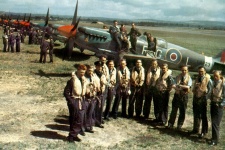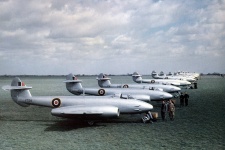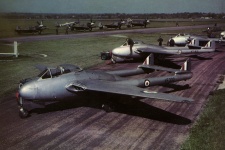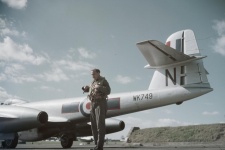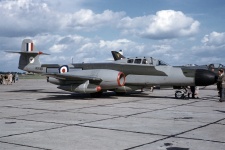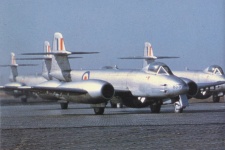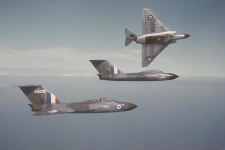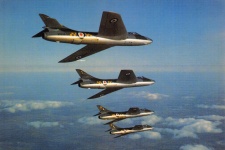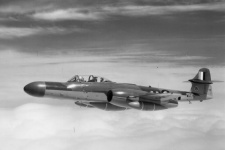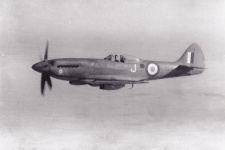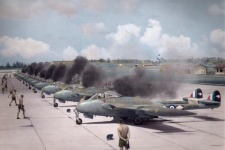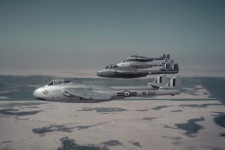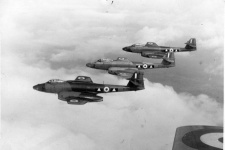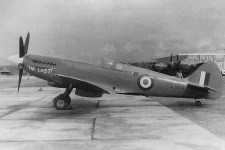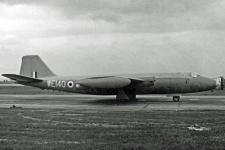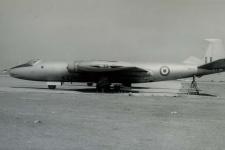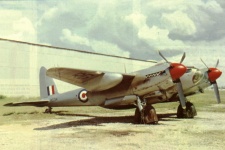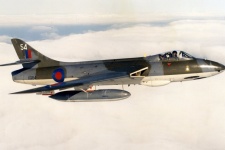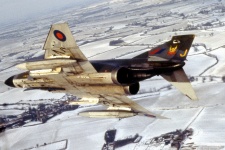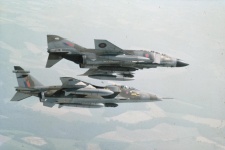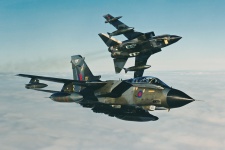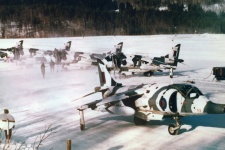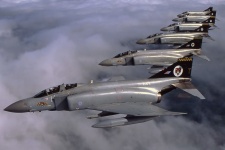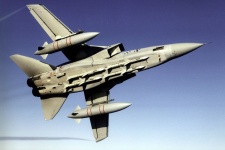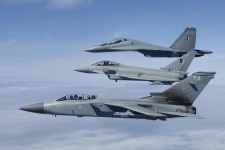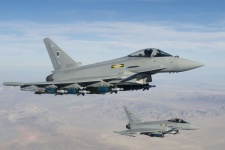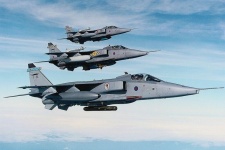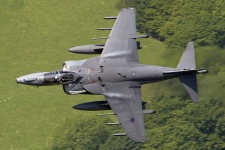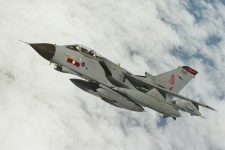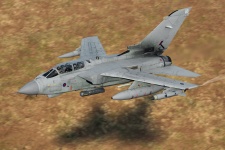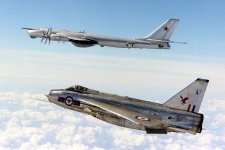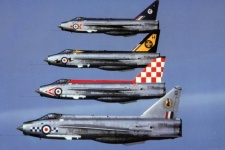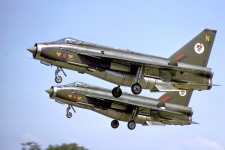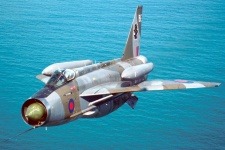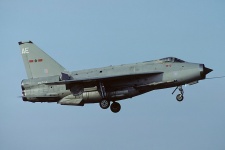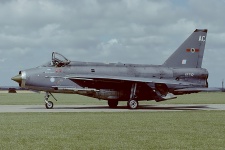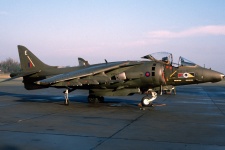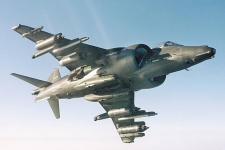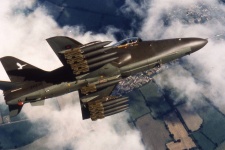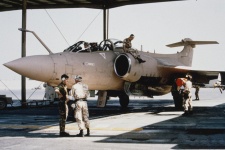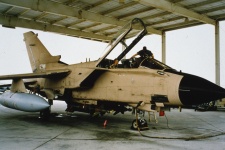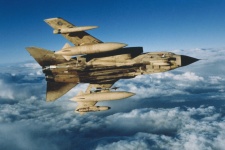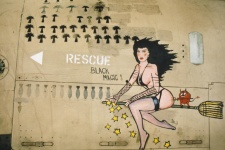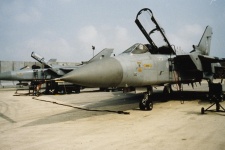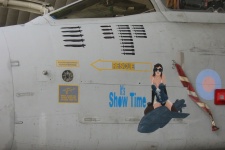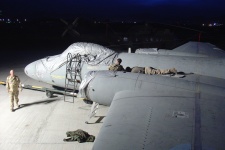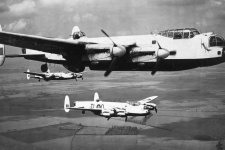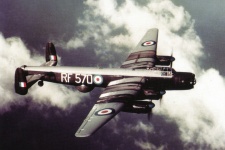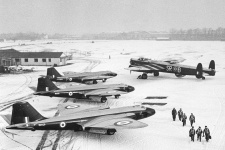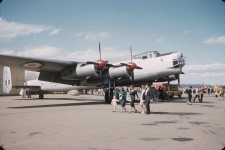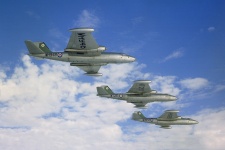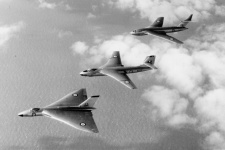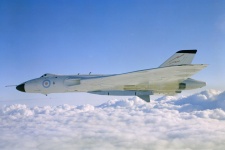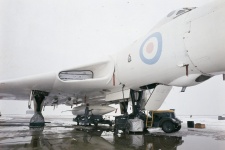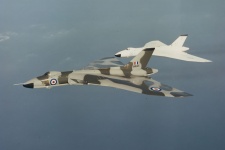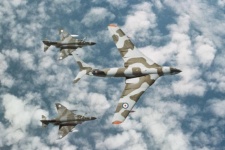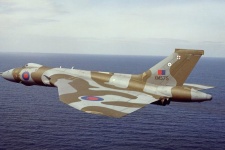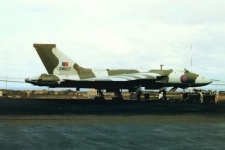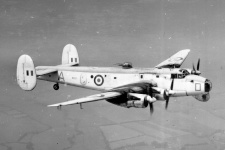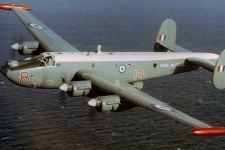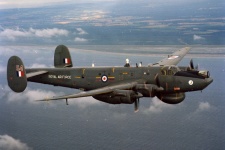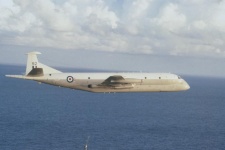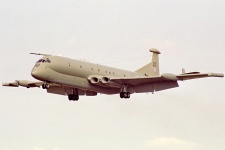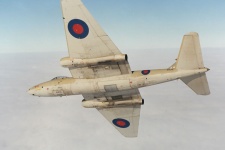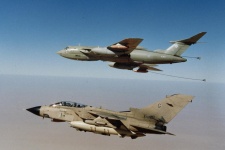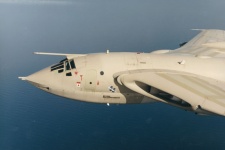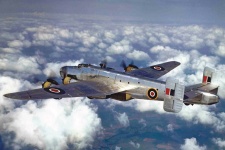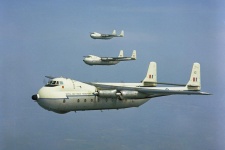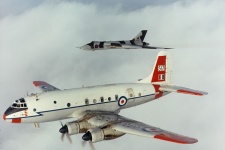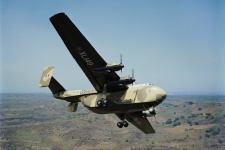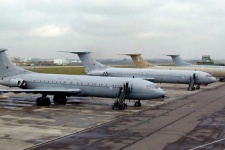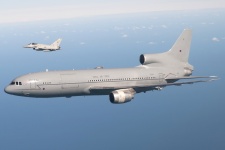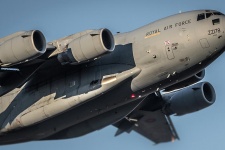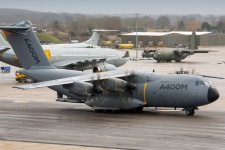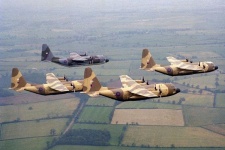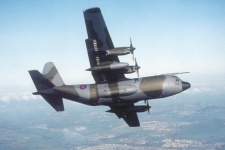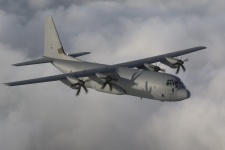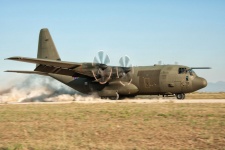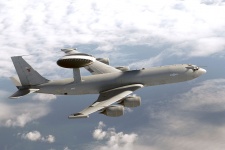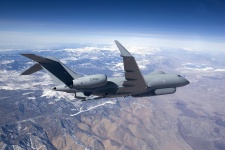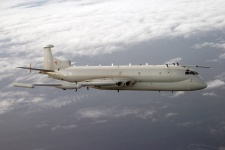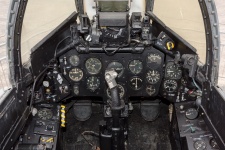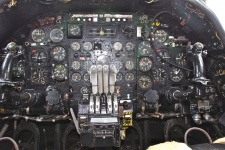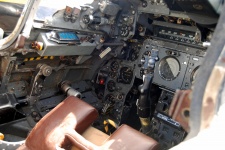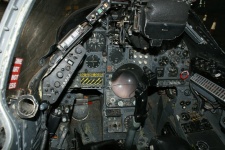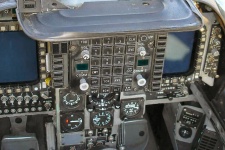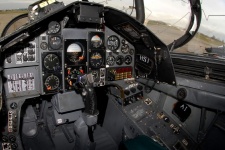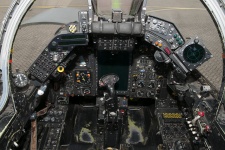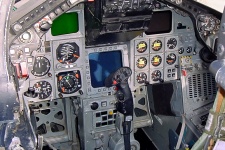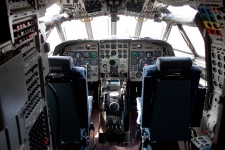Aircraft Colors and Camouflage, Royal Air Force (Modern)
![]()
Introduction to British color standards
The main color standard used on British military aircraft is known as British Standard BS 381, which was was introduced in 1930 as British Standard BS 381: Colours for Ready Mixed Paints. It was revised shortly thereafter in 1931 as British Standard BS 381C. This included a total of 57 colors known by their one or two-digit numbers and which were ordered in the following manner: blues, browns, greens, grays, reds, browns, and yellows. Neither white nor black were included. A further seven colors were later added bringing the total palette to 64 colors by the start of World War II. A few numbers were skipped, resulting in the numbering running from 1 to 73 with six of the seven newer colors not following the standard color order.
Numerous new colors were developed in the years before World War II while others were introduced after the war had started. From 1940, the Ministry of Aircraft Production (MAP) took charge of wartime color standards and this included all the major colors used on Royal Air Force (RAF) and Fleet Air Arm (FAA) aircraft. There were also two wartime updates of BS 381C (1943 and 1944) with a reduced palette of only 27 colors. However, only a handful of BS 381C colors were ever used for aircraft camouflage purposes. MAP colors did not have any numerical designation and were simply known by their names. Camouflage schemes were specified through numerous Air Ministry or Admiralty orders and were usually based around named two-tone disruptive schemes (such as the Temperate Sea Scheme) plus an underside color, and determined by aircraft role. US aircraft provided to the RAF/FAA via Lend-Lease were typically factory-painted in DuPont colors that closely approximated their MAP originals, and later in substitute paints from the ANA system.
A major new revision BS 381C took place in 1948, from which it was known as BS 381C: Colours for Specific Purposes which was expanded to 91 colors. A new three-digit numbering system was introduced where the first digit refereed to the color and last two two digits the shade. Color digits are: blue (1), green (2), yellow (3), brown (4), red (5), gray (6), and violet (7). Notably, no whites are included. Thankfully, almost all colors from the 1931 palette transfered their number to the last two digits so for example, No 1 Sky Blue became Sky Blue BS 101 and No 62 Middle Stone became Middle Stone BS 362. There were very few exceptions, such as No 43 Salmon Pink redesignated Salmon Pink BS 447 and some name changes like No 7 Dark Blue renamed Strong Blue BS 107. Most of the relevant MAP wartime colors were later incorporated into the 1964 update with 102 colors, which was described as 'for identification or other technical purposes, or for purposes based on long established practice', although there were some notable omissions such as Ocean Grey. The MAP palette was discontinued following this update. Further updates to BS 381C took place in 1980 (66 colors, plus 41 that were designated as obsolete), 1988 (84), and 1996 (91) and after the latter, all colors have been specified as being semi-matt. A different standard, BS 4800: Paint Colours for Building Purposes has occasionally been used on aircraft as well with some colors like Barley Grey and Hemp eventually incorporated into BS 381C.
Note: All paints in this section are referenced to the BS 381C 1948 three-digit nomenclature although many of the MAP wartime paints were not incorporated until 1964.
Contents:
- Tactical
- Day and Night Fighters (1947-1951)
- Day and Night Fighters (1951-1965)
- Overseas schemes (1951-1965)
- Photo-Reconnaissance (1951-1965)
- Tactical Aircraft (1965-1995)
- Air Defence Scheme (1978-Current)
- Tactical Aircraft (1995-Current)
- Lightning (1960-1988)
- Harrier II (1987-1995)
- Operation Granby / Operation Telic (1991/2003)
- Strategic
- Tiger Force / Bombers (1945-1951)
- Bombers (1951-1964)
- Bombers (1964-1984)
- Maritime Patrol (1947-1980)
- Hemp Scheme (1980-2010)
- Transports (1945-1996)
- Transports and Tankers (1996-Current)
- Hercules (1976-Current)
- ISTAR schemes (1991-Current)
- Other
External Links:
- British Standard BS 381C Colour Chart
- Other BS Colours
- Imperial War Museum Collections Online
- Air-Britain ABPic Library
- Aircraft of the R.A.F. and S.A.A.F. during World War II in Colour (Etienne du Plessis)
References:
There is no authoritative modern single reference on post-war RAF camouflage colors, and much of the information here has been picked from many disparate sources like forum posts (mainly on Britmodeller whose community this author massively thanks for their assistance) and magazine articles (namely Paul Lucas' 'Colour Connundrum' series on Scale Aircraft Modelling International). For more recent camouflage changes, the dates have been estimated on the basis of photographic evidence (via the ABPic Library); formal orders may have been issued before the dates given. There may be numerous inaccuracies and so any comments or corrections (with suitably authoritative references please) are welcome using my contact page.
Paint guide basics:
All colors in this page include a paint table with matches or equivalences from 19 different model paint ranges. Paints are considered matches if they are labeled with the intended color (either uniquely on together with another color). Paints are considered equivalences if they are close to the intended color but not labeled as such. The accuracy of any paint is independent of whether it is a match or an equivalence and these are described in the text (there can be poor matches and highly accurate equivalences). The following nomenclature is used in the paint tables and is based on matches or equivalences to US Insignia Red FS 11136:
| Paint | Match or equivalence type (label) |
| MP01 | Labeled to match one specific color (FS 11136) |
| MP02* | Labeled to match more than one color of same-country standards (FS 11136 / ANA 509)* |
| MP03** | Labeled to match more than one color of different-country standards (FS 11136 / BS 538) |
| MP04 (!) | Questionable accuracy of label match (doesn't look like FS 11136) |
| MP05 (?) | Questionable accuracy of label match, untested (doesn't look like FS 11136 in the bottle) |
| (MP06) | Close equivalent to FS 11136 (BS 538) |
| (MP07) (?) | Questionable equivalent to FS 11136 (Generic Gloss Red) |
* A single asterisk also denotes implicit matches for same-country standards where there is an official succession between standards. For example, H327* would match ANA 509 even if the label only references FS 11136 since ANA 509 is its official predecessor. This does not apply when there are considerable differences between successive paints (ex: Olive Drab No. 41/ANA 613/FS 34087) and this will be described in the text. By and large, however, single asterisk matches should be considered close enough to unique matches as to not be seriously questioned.
The paint charts make no distinction between gloss, semi-gloss, and matt variants of a color if the correct sheen is unavailable (ex: gloss FS 11136 will be a specific match for matt FS 31136 if the latter does not exist in the same paint range). Exceptions are made where there is a known or suspected color difference (ex: FS 24087 and 34087).
![]()
FIGHTERS
Day and Night Fighters (1947-51)
At the end of World War II, the majority of RAF tactical aircraft in service retained their long-standing camouflage colors which consisted of a topside Day Fighter Scheme (Ocean Grey and Dark Green) over Medium Sea Grey undersides, a combination that remained unchanged since first introduced in 1941. However, the possibility of leaving aircraft unpainted, as had been common practice in the USAAF since 1943, had been discussed since before the war was over and began to be implemented in the South-East Asia theater. On 16 April 1946, it was determined by Fighter Command to dispense with camouflage in place of an overall aluminium (also commonly referred to as 'silver') finish. Unlike USAAF practice, it was decided to use an aluminum finish rather than leaving the natural metal as it was believed that domestic metal finishes were not suitable to be left unpainted and would suffer excessive wear. The use of an aluminum finish on day fighters was formalized on 15 May 1947 (AMO A.413/47), with the caveat that existing aircraft would retain their camouflage until a refinish was required during maintenance. As a result, many aircraft retained wartime camouflage throughout the remainder of the decade.
Aluminium finishes, like all paint finishes, were specified by the Directorate of Technical Development. During World War II, aluminium finishes were covered by various DTD material specifications including DTD 63A (cellulose), DTD 83A (dope), and DTD 260A (synthetic). These finishes were applied depending on the surface involved (typically metal, fabric, or wood). The most widely used on metal surfaces were the dopes due to their flexibility, and these were covered by a number of newer post-war spefications DTD 751-753 from 1946. However, these finishes were seen as unsuitable for the faster jets that were gradually coming into service. In April 1949, a new metal finish was introduced, which became popularly known as High-Speed Silver. This was a pigmented synthetic resin primer, filler, and finishing coat which was polished to a very high gloss and which was made to a new material specification DTD 772. Use of High-Speed Silver was formally specified on 18 December 1952 (AMO A.658/52) although it was in use well before this, introduced on late production Meteor F.4s. It must be enfasized that neither the older aluminuim finishes nor High-Speed Silver were colors per se, nor did the introduction of the latter represent a new scheme in itself. Distinguishing the two finishes on photos is nearly impossible given the propensity of High-Speed Silver's glossier sheen to dull out in the field, in some cases resembling a light gray. As such, the use of High-Speed Silver should be taken as implicit only for aircraft built after 1949.
Unlike their daytime counterparts, night fighters did not move to aluminum finishes and instead, retained their late wartime scheme of overall Medium Sea Grey (later BS 637) with a disruptive topside pattern of Dark Green (later BS 641). This had a straight demarcation at mid-fuselage. It was also common practice to paint the radomes of night fighters Night (later BS 642) although this was not applied across the board.
Paint guide: Wartme colors are described in the RAF World War II page. Post-war versions of Medium Sea Grey and Dark Green are described in the following section.
- Aluminum: Any basic aluminum or silver paint will do, although lacquer-based paint is preferred due to their finer metallic pigments compared to acrylic which are often too grainy. An exception is Vallejo's Metal Color range which is widely considered the best non-lacquer metallic range currently on the market, second only to the old formula Citadel paints (sadly long discontinued). I am personally a huge fan of decanted Tamiya AS-12 (Bare Metal Silver) as it is much more forgiving than other laquer paints (such as the Alcad II range which is considered the gold standard for metallic modeling paint), dries quickly and rock hard (making it suitable as a primer as well), and has a semi-gloss finish that is more appropriate for aircraft in the field (only museum aircraft and warbirds are shiny and chrome). In order to maintain consistency, however, specific metal ranges are not included in the paint table.
- Hight-Speed Silver: Alcad II (ALC-125), Misison Models (MMM-009), and Xtracolor (X038) are the only paints specifically matched to HSS although the difference to a standard aluminum/silver is minor and so all the comments relevant to aluminum paint apply here. Despite its original gloss sheen, HSS would quickly look duller in the field and so the recommendation for decanted Tamiya AS-12 (Bare Metal Silver) remains. The paint table only includes paints that are distinct from an already existing aluminum in the same range, and are provided as close equivalents in parenthesis.
Links:
- British DTD
- Silver paint on inter war RAF aircraft (Key.Aero)
- Chrome Spit??? (FineScale Modeler)
- Why was there so little NMF in the RAF? (Britmodeller)
| BS 637 | BS 641 | |||
| Aluminium | High-Speed Silver | Medium Sea Grey | Dark Green | |
| Schemes | ||||
| Day Fighter (1947) | Overall | |||
| Day Fighter (1951) | Overall | |||
| Night Fighter | Lower | Upper Camo | ||
| Color matches | ||||
| Gunze Aqueous | H8 | - | H335 (!) | H73 |
| Gunze Mr. Color | C8 | - | C335 (!) / C363 | C23 / C361 |
| Humbrol | 56 | (11) | 165 | 116 |
| Model Master | 1781 | (1790) | 2058 | 2060 |
| Revell | 99 | (90) | - | 168 |
| Tamiya | XF-16 | - | XF-83 | XF-81 |
| Vallejo Model Air | 71.062 | (71.063) | 71.307 | 71.324 |
| Vallejo Model Color | - | (70.997) | 70.870** | - |
| AKAN | 76004 | (76010) | 70016 | 70020 |
| AK Interactive | - | - | AK 2013 | AK 2011 |
| AK Real Color | RC020 | - | RC289 | RC286 |
| AMMO by Mig | A.MIG-194 | - | A.MIG-246 | A.MIG-915 |
| Colourcoats | - | - | ACRN04 | ACRN09 |
| Hataka | HTK-_078 | (HTK-_003) | HTK-_034 | HTK-_016 |
| Lifecolor | LC-74 | - | UA 094 | UA 091 |
| Mission Models | MMM-003 | MMM-009 | MMP-094 | MMP-077 |
| Mr. Paint | MRP-81 | (MRP-3) | MRP-112 | MRP-110 |
| Xtracolor | X142 | X038 | X003 | X001 |
| Xtracrylix | XA1216 | - | XA1003 | XA1001 |
Day and Night Fighters (1951-1965)
Experience during the Korean War suggested that while ideal for combat at altitude, overall silver finishes were not ideal for camouflaging aircraft against the ground at lower altitudes. A re-introduction of camouflage on all UK-based fighters began to take place from 3 September 1953 (AMO A.228/53), using the topside pattern that was currently in use with the Tactical Air Forces abroad. The previously ubiquitous Ocean Grey was now replaced by Dark Sea Grey BS 638, which was slightly lighter and had a much less perceptible blueish hue. It also had a tendency to fade considerably, making the distinction with Medium Sea Grey often difficult. Meanwhile, Dark Green BS 641 was the direct successor to the wartime shade and was little different. One notable oddity was the numbering: the 600s in the new three-digit 1948 BS 381C range are greys, which means its inclusion in that particular range was a glaring mistake (or possibly done as a deliberate exception to keep it close to other, more widely used military greys). This would be rectified later (see below).
Unlike day fighters, night fighters did not adopt High-Speed Silver and instead, replaced the older wartime colors with the newer topside colors of Dark Sea Grey/Dark Green along with Medium Sea Grey BS 637 undersides. Ironically, this was a near repeat of the wartime Day Fighter Scheme, albeit with Dark Sea Grey replacing Ocean Grey, and with the only noticeable difference being the higher demarcation line typical of night fighters (at the widest point of the fuselage). Radomes were often painted Night BS 642 or a radotransparent coating (similar to Radome Tan FS 33613) thought this was not universal. The incorporation of more powerful radars on day fighters meant that night fighters gradually became obsolte in the 1960s, with some Meteor NF variants soldering on during this decade but eventually retired.
Paint guide:
- Dark Sea Grey BS 638: There is little differnce between the wartime and post-war shades. DSG is very well represented given its widespread post-war use. Despite its relative rarity in wartime service, Gunze offers a specific wartime version (H75/C25) as well as a post-war version (H331/C331). Modelers looking to replicate a significantly faded aircraft may want to use Medium Sea Grey.
- Dark Green BS 641/BS 241: There is little differnce between the wartime and post-war shades. Gunze includes both wartime (H73/C23) and post-war versions (H330/C331). Tamiya introduced a wartime match (XF-81) whose formula appears to have changed over the years, initially being a deep dark green but now looks more like an olive green. There are three Humbrol colors that have often been linked to RAF Dark Green: 30, 116, and 163. The first is too light and undoubtedly the most inaccurate of the three. However, 116 and 163 are much closer, being slightly lighter and darker respectively. Erring on the side of scale effect, 116 will be taken as the Humbrol match, with the caveat that 163 is an acceptable choice as well. There is no significant difference between BS 641 and BS 241 and so references to either should be taken as equivalent.
- Medium Sea Grey BS 637: There is little differnce between the wartime and post-war shades. Gunze's post-war representation H335/C335 is too blue. A newer version from a RAF wartime paint set (C363) appears to be a better representation. Tamiya's version (XF-83) is a great match while Xtracolor/Xtracrylix is too dark.
Links:
- Meteor NF.14 Question (Britmodeller)
| BS 637 | BS 638 | BS 641 | ||
| High-Speed Silver | Medium Sea Grey | Dark Sea Grey | Dark Green | |
| Schemes | ||||
| Day Fighter (1951) | Overall | |||
| Day Fighter (1953) | Lower | Upper camo | Upper camo | |
| Night Fighter (1951) | Lower | Upper camo | Upper camo | |
| Color matches | ||||
| Gunze Aqueous | - | H335 (!) | H331 | H330 |
| Gunze Mr. Color | - | C335 (!) / C363 | C331 | C330 |
| Humbrol | (11) | 165 | 164 | 116 |
| Model Master | (1790) | 2058 | 2059 | 2060 |
| Revell | (90) | - | - | 168 |
| Tamiya | - | XF-83 | XF-54 | XF-81 |
| Vallejo Model Air | (71.063) | 71.307 | 71.405 | 71.324 |
| Vallejo Model Color | (70.997) | 70.870** | 70.991** | - |
| AKAN | (76010) | 70016 | 70017 | 70020 |
| AK Interactive | - | AK 2013 | - | AK 2011 |
| AK Real Color | - | RC289 | RC296 | RC286 |
| AMMO by Mig | - | A.MIG-246 | - | A.MIG-915 |
| Colourcoats | - | ACRN04 | ACRN03 | ACRN09 |
| Hataka | (HTK-_003) | HTK-_034 | HTK-_140 | HTK-_016 |
| Lifecolor | - | UA 094** | UA 108** | UA 091** |
| Mission Models | MMM-009 | MMP-094 | - | MMP-077 |
| Mr. Paint | (MRP-3) | MRP-112 | MRP-113 | MRP-110 |
| Xtracolor | X038 | X003 | X004 | X001 |
| Xtracrylix | - | XA1003 | XA1004 | XA1001 |
Overseas schemes (1951-1965)
The post-war period saw considerable experimentation in camouflage schemes on RAF aircraft based overseas, with many transitioning to aluminum dope finishes, and others retaining some variant of their wartime camouflage. Ad hoc schemes were applied during this period, such as Egypt-based Spitfire FR.XVIIIs and Tempest F.VIs using Dark Earth and Light Slate Grey topsides over Medium Sea Grey undersides following various encounters against Israeli aircraft in 1949 (which did not go well for the RAF). On 1 June 1949, RAF overseas commands were re-organized into the Far East Air Force (FEAF), the Middle East Air Force (MEAF), while RAF units based in Germany were under the British Air Forces of Occupation (BAFO), which on 1 September 1951 returned to its former name of 2nd Tactical Air Force (and from 1 January 1959, RAF Germany). These three overseas commands are often referred to as the 'tactical air forces' on Air Ministry documentation, in order to make a distinction between UK-based aircraft.
From 18 December 1952 (AMO A.658/52) it was decided to standardize camouflage on all tactical air forces with topside colors of Dark Sea Gray BS 638 and Dark Green BS 641 over PRU Blue BS 626 undersides. Demarcation lines were low, using Pattern 1. This was applied to all tactical aircraft regardless of role (except night fighters), and may have been used experimentally before 1951. It is unclear (to this author) when the use of PRU Blue undersides was discontinued. All RAF fighters adopted topside camouflage from 1953 onward and the second half of the decade saw overseas aircraft use both PRU Blue and High-Speed Silver undersides. It is safe to say that by 1960s, there was no longer any difference in camouflage between UK and overseas aircraft.
There is some confusion between the overseas scheme and a short-lived scheme was applied to 'High-Altitude Short Range Fighters' and 'Jet Propelled Bombers' specified in the earlier AMO A.217/51. This consisted of a topside camouflage of Medium Sea Grey BS 637 and Light Slate Grey BS 639 over PRU Blue BS 626 undersides. Light Slate Grey was used mainly for 'shadow compensation' on wartime costal and naval biplanes and is a grey-green that is darker than its name suggests. Although the topside colors would appear superficially similar to the standard overseas scheme (particularly in a black and white photo), the main difference was the use of Pattern 2 demarcations, meaning that PRU Blue covered most of the fuselage sides. This scheme was seen on some Canberra B.2s, Meteor FR.9s, and Vampire FB.9s. It was promptly abandoned on 3 September 1953 (AMO A.228/53) although aircraft already painted may have retained it into the second half of the decade.
Paint guide:
- PRU Blue BS 636: PRU Blue is relatively well represented though notably absent from the Gunze range and a few others. It fades considerably and so there is a good margin for paints to get the right brightness; most appear to capture the darker freshly painted shade.
- Light Slate Grey BS 639: A few of the more modern ranges carry this color, though only Vallejo does among the traditional ones. Its closest equivalents from major Western palettes isSAC Bomber Green (FS 34159) or German Field Gray (RAL 7009).
Links:
- Meteor FR.9 Finished (Britmodeller)
| BS 636 | BS 638 | BS 641 | BS 637 | BS 639 | |
| PRU Blue | Dark Sea Grey | Dark Green | Medium Sea Grey | Light Slate Grey | |
| Schemes | |||||
| Overseas | Lower | Upper camo | Upper camo | ||
| Short Range | Lower / Sides | Upper | Upper | ||
| Color matches | |||||
| Gunze Aqueous | - | H331 | H330 | H335 (!) | - |
| Gunze Mr. Color | - | C331 | C330 | C335 (!) / C363 | - |
| Humbrol | 230 | 164 | 116 | 165 | (31) |
| Model Master | 2061 | 2059 | 2060 | 2058 | - |
| Revell | - | - | 168 | - | - |
| Tamiya | - | XF-54 | XF-81 | XF-83 | - |
| Vallejo Model Air | 71.109** | 71.405 | 71.324 | 71.307 | 71.406 |
| Vallejo Model Color | - | 70.991** | - | 70.870** | - |
| AKAN | - | 70017 | 70020 | 70016 | 70018 |
| AK Interactive | - | - | AK 2011 | AK 2013 | - |
| AK Real Color | RC297 | RC296 | RC286 | RC289 | - |
| AMMO by Mig | - | - | A.MIG-915 | A.MIG-246 | - |
| Colourcoats | ACRN14 | ACRN03 | ACRN09 | ACRN04 | ACRN05 |
| Hataka | HTK-_042 | HTK-_140 | HTK-_016 | HTK-_034 | - |
| Lifecolor | - | UA 108** | UA 091** | UA 094** | - |
| Mission Models | - | - | MMP-077 | MMP-094 | - |
| Mr. Paint | MRP-120 | MRP-113 | MRP-110 | MRP-112 | MRP-116 |
| Xtracolor | X008 | X004 | X001 | X003 | X037 |
| Xtracrylix | XA1008 | XA1004 | XA1001 | XA1003 | XA1037 |
Photo-Reconnaissance (1951-1965)
Photo-recon aircraft retained their wartime overall PRU Blue scheme in the immediate post-war period, but from 19 April 1951 (AMO A.217/51) began switching to Medium Sea Grey topsides and PRU Blue BS 636 undersides, using Pattern 2 (high demarcation). What follows is rather confusing as there appears to be considerable mixing of camouflage schemes on photo-recon aircraft in the late 1950s and 1960s, possibly because the two main post-war photo-recon aircraft (the Meteor and the Canberra) were used for a myriad of different roles; and in the Meteor's case, a fighter-reconnaissance aircraft. Meteor PR.10s were frequently seen using overseas camouflage since many squadrons were Germany-based. Canberra PR.3/7s were frequently painted in fighter colors (Dark Sea Grey/Dark Green over High-Speed Silver) as well.
It was also very common to see photo-recon aircraft painted in aluminum finish (pre-1949), and later, High-Speed Silver. This includes both the Meteor and Canberra, as well as the Mosquito PR.34 which remained in use until 1953 and photo-recon Lancasters (PR.1), of which a handful were converted. After 1965, most remaining photo-recon aircraft (mainly Canberra PR.7/9s) switched to the standard tactical camouflage of Dark Sea Grey/Dark Green over Light Aircraft Grey and, later, the Hemp scheme (see below).
Paint guide: All colors are described in previous sections.
Links:
- Meteor FR.9 Finished (Britmodeller)
| BS 636 | BS 637 | ||
| PRU Blue | Medium Sea Grey | High-Speed Silver | |
| Schemes | |||
| Photo-Recon | Lower / Sides | Upper | |
| Photo-Recon (Alt) | Overall | ||
| Color matches | |||
| Gunze Aqueous | - | H335 (!) | - |
| Gunze Mr. Color | - | C335 (!) / C363 | - |
| Humbrol | 230 | 165 | (11) |
| Model Master | 2061 | 2058 | (1790) |
| Revell | - | - | (90) |
| Tamiya | - | XF-83 | - |
| Vallejo Model Air | 71.109** | 71.307 | (71.063) |
| Vallejo Model Color | - | 70.870** | (70.997) |
| AKAN | - | 70016 | (76010) |
| AK Interactive | - | AK 2013 | - |
| AK Real Color | RC297 | RC289 | - |
| AMMO by Mig | - | A.MIG-246 | - |
| Colourcoats | ACRN14 | ACRN04 | - |
| Hataka | HTK-_042 | HTK-_034 | (HTK-_003) |
| Lifecolor | - | UA 094** | - |
| Mission Models | - | MMP-094 | MMM-009 |
| Mr. Paint | MRP-120 | MRP-112 | (MRP-3) |
| Xtracolor | X008 | X003 | X038 |
| Xtracrylix | XA1008 | XA1003 | - |
Tactical Aircraft (1965-1995)
Studies to develop a new aircraft finish that was more resistant to wear and to chemical agents resulted in a new non-metallic finish whose color was based on BS 9-095 from the BS 2660 palette, deemed to be closest to the existing silver finishes. This new 'light grey' eventually became known as Light Aircraft Grey BS 627 in a 1966 amendment to BS 381C. Its use on RAF tactical aircraft was formalized on 4 August 1965 (Defence Council Institute T.346/65). As the name implies, the new color was a slightly warm light gray which sits somewhere between the contemporary US colors of FS 36440 and FS 36622 (slightly closer to the former). In many photos it comes across as an off-white, although it can be clearly distinguished from the actual white pylons used on some aircraft like the Phantom. The topside disruptive pattern of Dark Sea Grey BS 638 and Dark Green BS 641 remained in place. In 1988, the erroneous numerical designation awarded to Dark Green was finally rectified, with the new color becoming Dark Green BS 241. It is believed that BS 241 is slightly more olive than the wartime version that served as the basis for BS 641, although the difference is trivial to the eye, especially on aircraft in the field. During this period, the three-tone schme was seen most famously on later versions of the Hunter as well as the Phantom and Harrier both of which entered service with the RAF in 1969. It was also seen on the Jaguar which was introduced in the 1970s and on prototype Tornados. By now, all major RAF aircraft were all-weather and, consequently, all dedicated night fighters were retired before Light Aircraft Grey became commonplace.
The use of Light Aircraft Grey undersides was mostly discontinued from 1980s onward, as remaining RAF tactical aircraft that were still painted in camouflage (namely Tornados, Jaguars, and Harriers; the Phantom was now mostly found in Air Defence greys) began adopting a two-tone wraparound scheme consisting of the two topside colors, Dark Sea Grey and Dark Green. This became the standard camouflage pattern on all RAF tactical aircraft that weren't tasked in the air defense role and lasted until 1995 when a new tactical grey scheme began to be implemented (see below). A notable interruption to the scheme was the use of Desert Pink and ARTF Grey in combat operations (1991 and 2003), which is described in a later section.
As the threat of conventional war began overtaking that of nuclear war, it became increasingly common to undertake Arctic training exercises in Norway. Many RAF aircraft participating in these exercises were painted in a white distempter, covering the areas painted in Dark Green.
Paint guide:
- Light Aircraft Grey BS 627: Light Aircraft Grey is considered a basic post-war RAF color and so is relatively well supplied, with Gunze and Humbrol offering it among the traditional ranges, and as would be expected, Colourcoats and Xtracolor/Xtracrylix as well. Most paints capture the warm tone of the color relatively well and this should not be a problematic color to reproduce (and if not available, either FS 36440 or FS 36622 are suitable alternatives, the latter possily preferred due to scale effect even if the former is technically closer).
- White Distemper: Basic matt white matches are included here, though Hataka (HTK-_153) is the only range to include a specific temporary white paint.
Links:
- Raf Dark Green (Britmodeller)
| BS 627 | BS 638 | BS 241 | ||
| Light Aircraft Grey | Dark Sea Grey | Dark Green | White Distemper | |
| Schemes | ||||
| Early | Lower | Upper camo | Upper camo | |
| Late | Wrap camo | Wrap camo | ||
| Arctic | Wrap camo | Wrap camo | ||
| Color matches | ||||
| Gunze Aqueous | H332 | H331 | H330 | H11 |
| Gunze Mr. Color | C332 | C331 | C330 | C62 |
| Humbrol | 166 | 164 | 116 | 34 |
| Model Master | - | 2059 | 2060 | 2142 |
| Revell | - | - | 168 | 05 |
| Tamiya | - | XF-54 | XF-81 | XF-2 |
| Vallejo Model Air | - | 71.405 | 71.324 | 71.001 |
| Vallejo Model Color | - | 70.991** | - | 70.842 |
| AKAN | 60014 | 70017 | 70020 | 78002 |
| AK Interactive | - | - | AK 2011 | AK 738 |
| AK Real Color | RC298 | RC296 | RC286 | RC004 |
| AMMO by Mig | - | - | A.MIG-915 | A.MIG-050 |
| Colourcoats | ACRN20 | ACRN03 | ACRN09 | C03 |
| Hataka | HTK-_217 | HTK-_140 | HTK-_016 | HTK-_153 |
| Lifecolor | - | UA 108** | UA 091** | LC 01 |
| Mission Models | - | - | MMP-077 | MMP-001 |
| Mr. Paint | MRP-374 | MRP-113 | MRP-110 | MRP-4 |
| Xtracolor | X015 | X004 | X001 | X405 |
| Xtracrylix | XA1015 | XA1004 | XA1001 | - |
Air Defence Scheme (1978-Current)
The RAF's interceptor fleet was the first to transition into all-grey schemes beginning with the Phantom around 1978. Known as the Air Defence Scheme, this consisted of a topside color of Camouflage Grey BS 626 (the time known as Barley Grey BS 18B21 from the BS 4800 palette before it was incorporated into BS 381C). This is a medium grey that is slightly warmer than neutral and would eventually be used in some way on all aircraft involved in air defense duties. Undersides were left in Light Aircraft Grey BS 627 as in the previous scheme. One unique feature of the Air Defence Scheme on Phantoms was the use of Medium Sea Grey BS 637 on the upper wings, from the wing root to the area where the wing fold would be located on naval aircraft; the outer section of the wing would remain Camouflage Grey. Another aircraft that would transition around this time to the Air Defence Scheme was the Lightning, although this is described in its own section below. In 1984, the Tornado ADV (Air Defence Variant) was introduced, of which the definitive F.3 variant would become the RAF's main interceptor for the next two decades. The Tornado F.3 adopted a slightly simpler two-tone version of the Air Defence Scheme, with Camouflage Grey topsides and Light Aircraft Grey undersides.
Around 2007, all RAF Tornados (both GR.1/4s and F.3s) began switching to an overall Medium Sea Grey BS 637 scheme. Radomes were also left in the same color although they tended to fade differently from the rest of the fuselage, producing some tonal difference. This same year saw the introduction into service of the Eurofighter Typhoon which would go on to fully replace the Tornado F.3 by 2011 in the interceptor role. From their introduction until the present day, Typhoons have been painted in overall Camouflage Grey BS 626, with slightly darker radomes suggestive of Medium Sea Grey. The Typhoon is currently the only British-built tactical aircraft currently in service with the RAF.
One interesting exception to the above were the second-hand F-4J(UK) Phantoms (also known as Phantom F.3) purchased from the US in 1984 in order to equip the re-formed No. 74 Squadron ('Tiger Squadron'). This was done in order to fill a gap in UK air defense following the transfer of No. 23 Squadron to the Falklands after the war. The F-4J(UK)s were painted in the US before transfer, using the closest Federal Standard colors to the normal Phantom three-tone. These were Flint Grey FS 36314 for the topside, Medium Grey FS 36270 for the upper wings, and Camouflage Grey FS 36440 for the undersides. The F-4J(UK)s were withdrawn in 1991, with some known to have having been repainted in proper RAF colors before retirement. A year later in 1992, all RAF Phantoms were retired from service.
Paint guide:
- Camouflage Grey BS 626: This is a widely-used modern RAF color though only available with Gunze and Humbrol among the traditional ranges. The contrast between BG and MSG is very subtle and should not appear too pronounced. Camouflage Grey is also a color found in the BS4800 palette where it is designated 18B21. In one of many cases of Vallejo re-labeling, 71.051 was originally labeled Barley Grey but is now Neutral Gray (FS 36173) and thus incorrect.
Links:
- McDonnell Phantom in British Service
- Camouflage and markings of No. 74 Squadron RAF Part 2
- Phantom FGR2 colour questions (Britmodeller)
| BS 627 | BS 626 | BS 637 | |
| Light Aircraft Grey | Camouflage Grey | Medium Sea Grey | |
| Schemes | |||
| Phantom | Lower | Upper | Upper wings |
| Tornado | Lower | Upper | |
| Tornado (2007) | Overall | ||
| Typhoon | Overall | ||
| Color matches | |||
| Gunze Aqueous | H332 | H334 | H335 (!) |
| Gunze Mr. Color | C332 | C334 | C335 (!) / C363 |
| Humbrol | 166 | 167 | 165 |
| Model Master | - | - | 2058 |
| Revell | - | - | - |
| Tamiya | - | - | XF-83 |
| Vallejo Model Air | - | - | 71.307 |
| Vallejo Model Color | - | - | 70.870** |
| AKAN | 60014 | - | 70016 |
| AK Interactive | - | - | AK 2013 |
| AK Real Color | RC298 | RC299 | RC289 |
| AMMO by Mig | - | A.MIG-207** | A.MIG-246 |
| Colourcoats | ACRN20 | ACRN08 | ACRN04 |
| Hataka | HTK-_217 | HTK-_142 | HTK-_034 |
| Lifecolor | - | UA 097 | UA 094** |
| Mission Models | - | - | MMP-094 |
| Mr. Paint | MRP-374 | - | MRP-112 |
| Xtracolor | X015 | X017 | X003 |
| Xtracrylix | XA1015 | XA1017 | XA1003 |
Tactical Aircraft (1995-Current)
The use of disruptive camouflage schemes came to an end by the middle of the 1990s when the RAF, like most major NATO air forces, began moving towards gray schemes that were more suitable for tactical operations at medium- and high-level (which became the norm after the end of the Cold War). The first such scheme was introduced around 1995 and consisted of Dark Sea Grey BS 638 as the topside, with Dark Camouflage Grey BS 629 covering most of the remainder of the airframe including the sides, undersides, fins, and all areasforward of the canopy. The two colors are very similar to each other and when freshly painted it was often difficult to spot the demarcation between them except from certain angles.
From around 2007 (possibly sooner), RAF tactical aircraft began switching to a single-tone grey scheme consisting of overall Medium Sea Grey BS 637. This applied to all remaining tactical aircraft in service except for the Typhoon (see above). The monotony was broken only by slightly darker radomes, which depending on fading, approximated any of the older two colors (Dark Camouflage Grey or Dark Sea Grey).
Paint guide:
- Dark Camouflage Grey BS 629: This is not a very well represented color, only Humbrol offers a specific match among the traditional paint ranges although it is better represneted among the newer ones. It is nearly identical to FS 36231 which is almost universally available. Beware the confusion with Dark Admiralty Grey used by the FAA which is darker and not as close as match to FS 36231.
| BS 629 | BS 638 | BS 637 | |
| Dark Camouflage Grey | Dark Sea Grey | Medium Sea Grey | |
| Schemes | |||
| Early (1995) | Lower / Sides | Upper | |
| Late (2007) | Overall | ||
| Color matches | |||
| Gunze Aqueous | - | H331 | H335 (!) |
| Gunze Mr. Color | - | C331 | C335 (!) / C363 |
| Humbrol | 156 | 164 | 165 |
| Model Master | - | 2059 | 2058 |
| Revell | - | - | - |
| Tamiya | - | XF-54 | XF-83 |
| Vallejo Model Air | 71.273** (!) | 71.405 | 71.307 |
| Vallejo Model Color | - | 70.991** | 70.870** |
| AKAN | - | 70017 | 70016 |
| AK Interactive | - | - | AK 2013 |
| AK Real Color | RC300 | RC296 | RC289 |
| AMMO by Mig | - | - | A.MIG-246 |
| Colourcoats | - | ACRN03 | ACRN04 |
| Hataka | HTK-_214 | HTK-_140 | HTK-_034 |
| Lifecolor | - | UA 108** | UA 094** |
| Mission Models | - | - | MMP-094 |
| Mr. Paint | MRP-375 | MRP-113 | MRP-112 |
| Xtracolor | X036 | X004 | X003 |
| Xtracrylix | XA1036 | XA1004 | XA1003 |
Lightning (1960-1988)
The English Electric Lightning was introduced in 1960 as a point-defense interceptor and was one of the most advanced jets of its day, flying in speeds excess of Mach 2 and with a rate of climb that has been matched by few aircraft since. It's advanced metallurgic engineering made it an ideal aircraft to be left in its natural metal finish (aluminum) in order to reduce drag, and so became one of the first and only RAF aircraft to enter service unpainted rather than using aluminium dope or High-Speed Silver. Although the fuselage and wings were generally left unpainted, it was common for many squadrons to paint the fins and spine in a particular color to harmonize with the increasingly colorful unit markings seen in the 1960s and 1970s. The most popular colors were Night BS 642, Roundel Blue BS 110, or Cherry Red BS 538, the latter two being the colors used on post-war roundels. White (most likely BS 00E55 from the BS 4800 palette) was also used to a lesser extent.
An exception to the NMF color scheme was provided to the pair of Lightning squadrons (No. 19 and No. 92 Squadrons) that were assigned to RAF Germany and which were tasked with low-level interception duties. These two squadrons sported a unique tscheme consisting of Dark Green BS 641 topsides and NMF undersides. In the 1970s, once the Phantom had been firmly established as the principal RAF interceptor, existing Lightning squadrons began switching to the then-standard disruptive camouflage pattern of Dark Sea Grey BS 638 and Dark Green BS 641 while retaining their NMF undersides.
Like most other RAF interceptors, the Lightning eventually adopted the Air Defense Scheme from the late 1970s and throughout the remainder of its service in the 1980s. Two different variants of the scheme were used, with two different demarcation patterns each. The darker scheme consisted of a three-tone combination of Dark Sea Grey BS 638 topsides, Medium Sea Grey BS 637 sides, and Camouflage Grey BS 626 undersides. The lighter scheme identical to the standard Air Defense Scheme two-tone, consisting of Medium Sea Grey as the sole color for the topside and sides and Camouflage Grey for the undersides. Each of the two schemes could have the demarcation line either at the height of the wing root or around the level of the missile rails.
Paint guide: All colors are described in previous sections.
Links:
- BAC Lightning camouflage greys (Britmodeller)
| BS 626 | BS 637 | BS 638 | BS 641 | ||
| Aluminium | Camouflage Grey | Medium Sea Grey | Dark Sea Grey | Dark Green | |
| Schemes | |||||
| Early | Overall | Overall | Overall | ||
| Late | Lower | Upper camo | Upper camo | ||
| RAF Germany | Lower | Upper | |||
| Air Defence (Dark) | Lower | Sides | Upper | ||
| Air Defence (Light) | Lower | Upper | |||
| Color matches | |||||
| Gunze Aqueous | H8 | H334 | H335 (!) | H331 | H330 |
| Gunze Mr. Color | C8 | C334 | C335 (!) / C363 | C331 | C330 |
| Humbrol | 56 | 167 | 165 | 164 | 116 |
| Model Master | 1781 | - | 2058 | 2059 | 2060 |
| Revell | 99 | - | - | - | 168 |
| Tamiya | XF-16 | - | XF-83 | XF-54 | XF-81 |
| Vallejo Model Air | 71.062 | - | 71.307 | 71.405 | 71.324 |
| Vallejo Model Color | - | - | 70.870** | 70.991** | - |
| AKAN | 76004 | - | 70016 | 70017 | 70020 |
| AK Interactive | - | - | AK 2013 | - | AK 2011 |
| AK Real Color | RC-020 | RC299 | RC289 | RC296 | RC286 |
| AMMO by Mig | A.MIG-194 | A.MIG-207** | A.MIG-246 | - | A.MIG-915 |
| Colourcoats | - | ACRN08 | ACRN04 | ACRN03 | ACRN09 |
| Hataka | HTK-078 | HTK-_142 | HTK-_034 | HTK-_140 | HTK-_016 |
| Lifecolor | LC-74 | UA 097 | UA 094** | UA 108** | UA 091** |
| Mission Models | MMM-003 | - | MMP-094 | - | MMP-077 |
| Mr. Paint | MRP-3 | - | MRP-112 | MRP-113 | MRP-110 |
| Xtracolor | X142 | X017 | X003 | X004 | X001 |
| Xtracrylix | XA1216 | XA1017 | XA1003 | XA1004 | XA1001 |
Harrier II (1987-1995)
The updated Harrier II came into RAF service 1987 and featured a new two-tone scheme designed for close support and interdiction operations in Germany. The topside color consisted of NATO Green BS 285, also used on contemporary tanks like the Challenger and helicopters. It was originally specified by British Defence Standard 00-23 Issue 1 in October 1980 and is slightly different from the ubiquitous NATO Green used on other NATO tanks and helicopters, being slightly darker and more olive colored (in fact, each country had its own version of NATO Green). It is also optimized for infra-red reflectivity (IRR), hence why it is often referred to as 'NATO Green IRR'. Undersides were painted Lichen Green BS 12B25 (later added in 1996 to the BS 381C palette as Spruce Green BS 284). This color is taken from the BS 4800 palette and has never been incorporated into BS 381C. It is lighter, forest green that harmonizes well with the topside, giving the Harrier II very good concealment in woodland regions such as Germany. Demarcation lines for this scheme tended to be relatively straight (both horiontal and vertical), and was notable for having pylons and fuel tanks painted in the topside color in the frontal halves. This scheme appears to have to also have been implemented experimentally on Harrier GR.3s during Exercise Match Coat in 1984 though probably never used operationally on this variant.
The NATO/Lichen green scheme was relatively short lived, being most commonly associated with the Harrier GR.5 (which used it throuhgout the entirety of its service life) as well as early GR.7s. By 1995, all Harriers began switching to the standard tactical grey scheme of Dark Sea Gray BS 638 and Dark Camouflage Grey BS 629 described above.
Paint guide:
- Lichen Green BS 12B25/BS 284: This is a rare case of a paint that doesn't even have a remotely close FS equivalent. Unsurprisingly, it is very poorly represented, with only Hataka and Xtracolor offering matches. Humbrol 102 ('Army Green') is frequently taken as a close equivalent and so is included here in parenthesis.
- NATO Green BS 285: The following cannot be emphasized enough: this is not equivalent to the NATO Green used on other NATO vehicles and helicopters but a British-specific shade that is darker and more olive, being closest to FS 34096 or FS 34079. As such, other NATO Green paints are not considered even close equivalents. Sadly, only a handful of ranges carry BS 285, with Hataka being the only option in Acrylic.
| BS 12B25 | BS 285 | |
| Lichen Green | NATO Green | |
| Schemes | ||
| Early | Lower | Upper camo |
| Late | Wrap camo | |
| Color matches | ||
| Gunze Aqueous | - | - |
| Gunze Mr. Color | - | - |
| Humbrol | (102) | - |
| Model Master | - | - |
| Revell | - | - |
| Tamiya | - | - |
| Vallejo Model Air | - | - |
| Vallejo Model Color | - | - |
| AKAN | - | - |
| AK Interactive | - | - |
| AK Real Color | - | - |
| AMMO by Mig | - | - |
| Colourcoats | - | ARB06 |
| Hataka | HTK-_216 | HTK-_215 |
| Lifecolor | - | - |
| Mission Models | - | - |
| Mr. Paint | - | MRP-381 |
| Xtracolor | X024 | X018 |
| Xtracrylix | - | - |
Operation Granby / Herrick / Telic (1991/2003)
Ahead of its deployment to the Gulf as part of Operation Granby, the RAF painted its low-level tactical aircraft in a special washable paint known as Desert Pink, which being a special paint was not in any British Standard palette. This was a desert sand color with a pinkish hue when freshly painted but which tended to fade closer to a tan, particularly in the heat and sun of the Middle East. Given the long deployment before the Gulf War began on 15 January 1991, most aircraft looked quite faded and worn by the time combat operations began, and this only worsened as the war progressed. The liberal use of nose art by RAF crews also resulted in constant re-painting and touch ups, which gave the aircraft a distincitive patchy look, exacerbated by the excessive chipping that is natural from most washable paints. Despite this, Desert Pink has since become an iconic military camoflage color, not least because it contrasted so heavily with the then-standard RAF wraparound camouflage but also because it made RAF aircraft stand out considerably since the US did not apply desert camouflage for its own aircraft (except experimentally on a handful of aircraft).
Aircraft that were painted in Desert Pink included the Jaguar, Buccaneer, and the ground attack/reconnaissance versions of the Tornado (GR.1/1A). Air defense versions of the Tornado (F.3) retained their normal camouflage given that they operated at high altitude and behind the front lines. The use of Desert Pink was discontinued after the Gulf War, although a very similar color known as Desert Sand BS 380 was eventually introduced into the BS 381C palette in 1996. This was mostly used on vehicles, however, since no major RAF aircraft was painted in desert colors for the 2003 Iraq War.
A new washable paint was also introduced shortly after the end of the war, known as ARTF Grey, the acryonym standing for 'Alkaline Removable Temporary Finish'. This color is widely accepted to be closest to Camouflage Grey BS 626 (although some sources suggest Medium Sea Grey BS 637). ARTF Grey was first used operationally on Jaguars and Harriers patrolling Northern Iraq during Operation Warden in September 1991, but it was also used on Harrier GR.7s and Tornado GR.4s during Operation Telic (the invasion of Iraq) in 2003, and has been seen on Canberra PR.9s around mid-decade as well.
Paint guide:
- Desert Pink: Despite the huge popularity of Gulf War modeling subjects, Desert Pink is not as widely available as one would think, with only Humbrol offering it as 'Desert Sand' (250) and Vallejo recently introducing it as well (71.400) among the traditional paint ranges. Fortunately the newer ranges are better sorted, and Colourcoats, Mr. Paint, and Xtracolor/Xtracrylix all make excellent versions. Hataka's version is matched to FS 36279 while AKAN's is labeled Desert Sand BS 380 which is an acceptable equivalent.
- ARTF Grey: It is believed to be closest to Camouflage Grey BS 626 and so is matched as such.
| Desert Pink | ARTF Grey | |
| Schemes | ||
| Granby | Overall | |
| Telic | Overall | |
| Color matches | ||
| Gunze Aqueous | - | H334 |
| Gunze Mr. Color | - | C334 |
| Humbrol | 250 | 167 |
| Model Master | - | - |
| Revell | - | - |
| Tamiya | - | - |
| Vallejo Model Air | 71.400 | - |
| Vallejo Model Color | - | - |
| AKAN | 70041 | - |
| AK Interactive | - | - |
| AK Real Color | - | RC299 |
| AMMO by Mig | - | A.MIG-207** |
| Colourcoats | ACRN16 | ACRN08 |
| Hataka | (HTK-_068) | HTK-_142 |
| Lifecolor | - | UA 097 |
| Mission Models | - | - |
| Mr. Paint | MRP-185 | - |
| Xtracolor | X032 | X017 |
| Xtracrylix | XA1032 | XA1017 |
![]()
BOMBERS
Tiger Force / Post-War Bombers (1945-51)
During the immediat post-war era, RAF bombers (most of which were night bombers) were left in their wartime colors of a topside disruptive Temperate Land Scheme (Dark Earth and Dark Green) over Night undersides. However, a different scheme was developed for use with the Tiger Force, the name of a RAF and Commonwealth bomber force composed mainly of Lancasters which was to be sent to the Pacific for operations against Japan. Tiger Force bombers (which eventually composed 22 squadrons though this was later reduced) were painted with white topsides and Night (later BS 642) undersides, with a very low demarcation, the use of white was used for thermal reflection purposes in the Pacific sun. The dropping of the atomic bombs and the sudden end to the war against Japan eventually rendered Tiger Force moot and it was disbanded on October 31st but aircraft that had already been repainted retained their Tiger Force colors, which was also adopted on non-Tiger Force squadrons as well as many Avro Lincoln bombers.
Preference for a two-tone scheme continued, albeit with a more suitable topside color for UK skies. This resulted a swith to Medium Sea Grey (later BS 637) topsides around 1947, retaining Night undersides with low demarcations. This became the standard camouflage scheme for all bombers, both strategic and tactical, and aside from the Lancaster and Lincoln 'heavies', was also seen on Beaufighters, Brigands, Canberras, and Mosquitos. During this period there were also large numbers of Commonwealth heavy bomber squadrons which on many occasions continued to operate alongside those of the RAF, particularly outside the UK. Those of the Royal Australian Air Force (RAAF) were notable for leaving their aircraft in natural metal finish (aluminium) as per late wartime tradition.
Paint guide:
- White: There has never been any white color specified in BS 381C, and there are four separate whites in BS 4800 of which the most likely match is BS 00E55. References are found to BS 302 Identification White at BS 802 White but neither of these colors have ever appeared on an BS 381C palette (although the latter is believed to exist commercially). In practice, however, the white used on RAF/FAA aircraft tends to yellow with age and look like an off-white similar to Insignia White FS 17875. As a result, matches to the latter are probably preferred for any model (see any of the US pages for references). The paint chart includes only matches to basic white.
Links:
- Silver paint on inter war RAF aircraft (Key.Aero)
| BS 642 | BS 637 | |||
| Night | White | Medium Sea Grey | Aluminium | |
| Schemes | ||||
| Tiger Force | Lower | Upper | ||
| Bombers (1947) | Lower | Upper | ||
| RAAF | Overall | |||
| Color matches | ||||
| Gunze Aqueous | (H77) | H11 | H335 (!) | H8 |
| Gunze Mr. Color | C125 | C62 | C335 (!) / C363 | C8 |
| Humbrol | - | 34 | 165 | 56 |
| Model Master | - | 2142 | 2058 | 1781 |
| Revell | - | 05 | - | 99 |
| Tamiya | (XF-85) | XF-2 | XF-83 | XF-16 |
| Vallejo Model Air | (71.315) | 71.001 | 71.307 | 71.062 |
| Vallejo Model Color | (70.862) | 70.842 | 70.870** | - |
| AKAN | (79043) | 78002 | 70016 | 76004 |
| AK Interactive | AK 2066 | AK 738 | AK 2013 | - |
| AK Real Color | (RC022) | RC004 | RC289 | RC-020 |
| AMMO by Mig | (A.MIG-033) | A.MIG-050 | A.MIG-246 | A.MIG-194 |
| Colourcoats | (ACRN17) | C03 | ACRN04 | - |
| Hataka | - | HTK-_101 | HTK-_034 | HTK-078 |
| Lifecolor | - | LC 01 | UA 094 | LC-74 |
| Mission Models | MMP-108 | MMP-001 | MMP-094 | MMM-003 |
| Mr. Paint | (MRP-255) | MRP-4 | MRP-112 | MRP-3 |
| Xtracolor | X012 | X405 | X003 | X142 |
| Xtracrylix | XA1012 | - | XA1003 | XA1216 |
Bombers (1951-1964)
High-Speed Silver was introduced in 1949 as a more effective finish for fast aircraft and was quickly implemented on most jets including both fighter and bombers. The first jet bomber in the RAF arsenal was the Canberra, a medium bomber introduced in 1951 and which used a number of different schemes in its early years, one of which was an overall HSS finish. The Canberra was followed into service by the Valiant in 1955, the first of a trio of new strategic jet bombers which also included the Vulcan (1956) and Victory (1958). Together, these would be affectionately known as the 'V-Bombers' and would compose the RAF's nuclear deterrent force for much of the Cold War.
Valiants were seen operationally in HSS as were some prototype and early production Vulcans and Victors. However, in 1957 a new paint known as Anti-Flash White was developed for the V-Bomber fleet. It is unclear whether there were any particular characteristics of this paint that enhanced its thermal reflection properties or whether the name simply referred to its purpose (as this author suspects); experience with the Fleet Air Arm suggests that it was not visibly different from the standard white used on most aircraft undersides from the 1960s onward, at least compared to the one FAA known to have used Anti-Flash White, the Buccaneer. In addition to the overall Anti-Flash White, the V-Bomber fleet used pale roundels and markings during this period for similar thermal reflective purposes, although they later changed back to hi-viz markings. Although the scheme was relatively short-lived (camouflage was re-implemented in 1964), it is definitely among the most visually stunning schemes used on any RAF post-war aircraft and one that is nearly synonymous with the iconic V-Bombers, the last British-built bombers ever designed.
Paint guide:
- Anti-Flash White: Colourcoats (ARCN37) and Hataka (HTK-_322) are the only ranges to offer a specific RAF Anti-Flash White. There does not appear to be any discernible difference with the standard white used on RAF/FAA aircraft. Matches to generic off-whites are included as close equivalents in parenthesis in the event that the modeler prefers a slightly tinted white instead. V-Bombers tended to be kept much cleaner than normal aircraft and thus looked closer to a true white in photographs.
Links:
- Why was there so little NMF in the RAF? (Britmodeller)
| High-Speed Silver | Anti-Flash White | |
| Schemes | ||
| Bombers (1951) | Overall | |
| Bombers (1957) | Overall | |
| Color matches | ||
| Gunze Aqueous | - | (H21) |
| Gunze Mr. Color | - | (C69) |
| Humbrol | (11) | - |
| Model Master | (1790) | - |
| Revell | (90) | - |
| Tamiya | - | - |
| Vallejo Model Air | (71.063) | - |
| Vallejo Model Color | (70.997) | (70.820) |
| AKAN | (76010) | (73146) |
| AK Interactive | - | - |
| AK Real Color | - | (RC-013) |
| AMMO by Mig | - | - |
| Colourcoats | - | ACRN37 |
| Hataka | (HTK-_003) | HTK-322 |
| Lifecolor | - | - |
| Mission Models | MMM-009 | - |
| Mr. Paint | (MRP-3) | - |
| Xtracolor | X038 | - |
| Xtracrylix | - | - |
Cold War Bombers (1964-1984)
As the sophistication of Soviet air defenses increased (as evidenced by the shooting down of a high-altitude US U-2 spy plane in 1960), the V-Bomber fleet gradually switched to low-level penetration from January 1964 onward and which required the re-introduction of camouflage; the first camouflaged Valiant was seen in public on 18 May 1964 at an air display at RAF North Weald. Unlike fighters, the two-tone scheme used for bombers was lighter, using Medium Sea Grey BS 637 rather than Dark Sea Grey for its disruptive pattern combined with Dark Green BS 641. Undersides were kept in Anti-Flash White. From 1966, Light Aircrat Grey BS 627 was introduced as an underside color for fighters and this too eventually found its way into the V-Bomber fleet, although AFW was still the basic underside color well into the 1970s. The year 1968 also saw the creation of RAF Strike Command, which merged Fighter and Bomber Commands into a single operational structure.
The 1960s saw the retirement of two of the three V-Bombers, the first being the Valiant (1965) and later the Victor (1968), in both cases due to metal fatigue following the switch to low-level operations. However, the Victor continued to serve successfully as a tanker, a role which it fulfilled until 1993 making it the longest-serving of the V-Bombers even if not in its original role. Victors retained their standard bomber camouflage until switching to the Hemp scheme in the 1980s (see below). From 1968, the Vulcan remained the sole RAF strategic bomber and saw a number of minor camouflage alterations in its final years of service. The first was a switch to a two-tone wrap-around scheme from around 1980. This was in line with other RAF fighters, although the topside colors of Medium Sea Grey and Dark Green were retained. A number of Vulcans also participated in the Falklands War, performing the celebrated (although tactically useless) 'Black Buck' strikes against Port Stanley's airfield and air defenses. Flying from Ascension Island, these 16-hour flights were the longest bombing sorties ever taken at the time, and were accomplished using Victor tankers for aerial refueling. For these missions, Vulcans were painted with Dark Sea Grey BS 638 undersides. The Vulcan was retired shortly thereafter in 1984.
An exception to the bomber camouflage colors was the Canberra, which probably due to its tactical nature, used Dark Sea Grey instead of Medium Sea Grey as one of its two topside colors.
Paint guide: All colors are described in previous sections.
Links:
| BS 627 | BS 637 | BS 641 | ||
| Anti-Flash White | Light Aircraft Grey | Medium Sea Grey | Dark Green | |
| Schemes | ||||
| Bombers | Overall | |||
| Bombers (1970s) | Lower | Upper camo | Upper camo | |
| Bombers (1980s) | Wrap camo | Wrap camo | ||
| Color matches | ||||
| Gunze Aqueous | (H21) | H332 | H335 (!) | H330 |
| Gunze Mr. Color | (C69) | C332 | C335 (!) / C363 | C330 |
| Humbrol | - | 166 | 165 | 116 |
| Model Master | - | - | 2058 | 2060 |
| Revell | - | - | - | 168 |
| Tamiya | - | - | XF-83 | XF-81 |
| Vallejo Model Air | - | - | 71.307 | 71.324 |
| Vallejo Model Color | (70.820) | - | 70.870** | - |
| AKAN | (73146) | 60014 | 70016 | 70020 |
| AK Interactive | - | - | AK 2013 | AK 2011 |
| AK Real Color | (RC-013) | RC298 | RC289 | RC286 |
| AMMO by Mig | - | - | A.MIG-246 | A.MIG-915 |
| Colourcoats | ACRN37 | ACRN20 | ACRN04 | ACRN09 |
| Hataka | HTK-322 | HTK-_217 | HTK-_034 | HTK-_016 |
| Lifecolor | - | - | UA 094** | UA 091** |
| Mission Models | - | - | MMP-094 | MMP-077 |
| Mr. Paint | - | MRP-374 | MRP-112 | MRP-110 |
| Xtracolor | - | X015 | X003 | X001 |
| Xtracrylix | - | XA1015 | XA1003 | XA1001 |
Maritime Patrol (1947-1980)
In the immediate post-war years, Coastal Command patrol aircraft were finished in their wartime scheme of Extra Dark Sea Grey over White. However, the dark uppersides were shown to have very poor heat reflection and so from 15 May 1947 (AMO A.413/47) it was determined to switch to the lighter Medium Sea Grey BS 637 while retaining the White undersides. In 1951, the plethora of wartime patrol aircraft (many of them Lend-Lease) would begin to be replaced by the British-built Avro Shackleton, which would become the main RAF maritime patrol aircraft until the 1970s. In 1955, a change to the patrol scheme took place driven by the fact that the lighter colors tended to get considerably dirty. The new scheme in use on MR (Maritime Reconnaissance) variants involved the use of overall (gloss) Dark Sea Grey BS 638, with a topside color of White which would cover only the upper fuselage (not the wings). A slightly revised scheme was used on Shackleton AEW (Airborne Early Warning) variants, which consisted of overall Dark Sea Grey. It was also used on a small number of MR aircraft although white upper fuselages were the norm. In all cases, anti-glare panels in Night BS 642 were common. Like the wartime 'heavies', all of the two-tone schemes used the higher, Pattern 2 demarcations. As has been mentioned in previous sections, Dark Sea Grey is highly prone to fading and this would be exacerbated in martime operations, which explains why it appears considerably lighter on many photos (approximating Medium Sea Grey).
The successor to the Shackleton, the Nimrod, was introduced in 1961 with a considerably different scheme than any patrol aircraft before it. This consisted of White topsides and Light Aircraft Grey BS 627 for the lower fuselage. Being a color that is strongly affected by contrast with the colors next to it, Light Aircraft Grey looks decidely darker than in other schemes and is often confused for Medium Sea Grey, although this is incorrect. Most Nimrods would transition to the Hemp scheme in the 1980s (see below).
Paint guide: All colors are described in previous sections.
| BS 627 | BS 637 | BS 638 | ||
| White | Light Aircraft Grey | Medium Sea Grey | Dark Sea Grey | |
| Schemes | ||||
| Patrol (1947) | Lower | Upper camo | ||
| Patrol (1955) | Upper | Lower | ||
| Patrol (AEW) | Overall | |||
| Nimrod (Early) | Upper | Lower | ||
| Color matches | ||||
| Gunze Aqueous | H11 | H332 | H335 (!) | H331 |
| Gunze Mr. Color | C62 | C332 | C335 (!) / C363 | C331 |
| Humbrol | 34 | 166 | 165 | 164 |
| Model Master | 2142 | - | 2058 | 2059 |
| Revell | 05 | - | - | - |
| Tamiya | XF-2 | - | XF-83 | XF-54 |
| Vallejo Model Air | 71.001 | - | 71.307 | 71.405 |
| Vallejo Model Color | 70.842 | - | 70.870** | 70.991** |
| AKAN | 78002 | 60014 | 70016 | 70017 |
| AK Interactive | AK 738 | - | AK 2013 | - |
| AK Real Color | RC004 | RC298 | RC289 | RC296 |
| AMMO by Mig | A.MIG-050 | - | A.MIG-246 | - |
| Colourcoats | C03 | ACRN20 | ACRN04 | ACRN03 |
| Hataka | HTK-_101 | HTK-_217 | HTK-_034 | HTK-_140 |
| Lifecolor | LC 01 | - | UA 094** | UA 108** |
| Mission Models | MMP-001 | - | MMP-094 | - |
| Mr. Paint | MRP-4 | MRP-374 | MRP-112 | MRP-113 |
| Xtracolor | X405 | X015 | X003 | X004 |
| Xtracrylix | - | XA1015 | XA1003 | XA1004 |
Hemp Scheme (1980-2010)
From around 1980, a new scheme was introduced for various non-bomber strategic schemes and which was based around BS 10B21 from the BS 4800 palette and which was introduced in 1996 to BS 381C as Camouflage Beige BS 389. This color has had innumerable commercial paint names but is more popularly known as 'Hemp'. Hemp is a yellow-grey that was chosen as a suitable compromise between camouflage in the air as well as dispersed in the ground. It tends to vary considerably depending on lightning. For example, the bulged upper half of the Nimrod and Victor tends to look darker than the lower half, making it appear like two different colors which is not the case. The underside color in this scheme is Light Aircraft Grey BS 627, whose warm tone harmonizes very well with the Hemp topsides and almost looks like a lighter version of the same hue. The most well-known users of the Hemp Scheme are the Nimrod maritime patrol aircraft, the VC10 tanker, the tanker version (K.2) of the Victor, and the late photo-reconnaissance versions (PR.9) of the Canberra. The Hemp Scheme was used on all of these aircraft until their retirement, the last of these being the Nimrod in 2010.
Paint guide:
- Camouflage Beige BS 389: Hemp, like most major post-war RAF colors, is generally well represented, with Gunze and Humbrol carrying it among the traditional paint ranges, and ample coverage among the newer ones. It is usually matched specifically to the BS color (either 10B21 or 389), the exception being Vallejo which has an FS and RAL match and actually doesn't reference BS at all. Nevertheless, Hemp is known to be very close to RAL 7034 which means the Vallejo color should not be too far off the mark.
| BS 627 | BS 389 | |
| Light Aircraft Grey | Camouflage Beige | |
| Schemes | ||
| Hemp | Lower | Upper |
| Color matches | ||
| Gunze Aqueous | H332 | H336 |
| Gunze Mr. Color | C332 | C336 |
| Humbrol | 166 | 168 |
| Model Master | - | - |
| Revell | - | - |
| Tamiya | - | - |
| Vallejo Model Air | - | 71.023** |
| Vallejo Model Color | - | - |
| AKAN | 60014 | 70045 |
| AK Interactive | - | - |
| AK Real Color | RC298 | RC301 |
| AMMO by Mig | - | - |
| Colourcoats | ACRN20 | ACRN38 |
| Hataka | HTK-_217 | HTK-_262 |
| Lifecolor | - | - |
| Mission Models | - | - |
| Mr. Paint | MRP-374 | MRP-377 |
| Xtracolor | X015 | X016 |
| Xtracrylix | XA1015 | XA1016 |
Transports (1945-1996)
At the end of the World War II, the RAF transport fleet was composed of around 2,000 Lend-Lease Dakotas (which would have to be returned or paid off) plus a smaller number of transport conversions of other RAF aircraft (mostly bombers). The post-war period saw the introduction of a large number of British-built transports to make up for the dependency on the Dakota, most of these being military conversions of civil airliners. Although some immediate post-war aircraft retained their wartime camouflage, most were given an aluminium finish (and possibly High-Speed Silver after its introduction in 1949). This changed in the 1950s with the introduction of a Transport Command scheme that was very much influenced by civil airliner livery. This consisted of a topside aluminum finish with white undersides. A Roundel Blue BS 110 cheatline was painted at the widest point of the fuselage, much like US and Soviet transports at the time, with the RAF's cheatline being unique for having a lighting-bolt like break near the front of the fuselage. This scheme would last until 1965 with the introduction of Light Aircraft Grey BS 627 as an underside color gradually replacing aluminum/High-Speed Silver.
A notable departure from the standard Transport Command scheme was a special scheme intended for use overseas (particularly the Middle East) but which eventually became the default scheme for tactical transports. This consisted of a topside camouflage pattern of Light Stone BS 361 and Dark Earth BS 450, over Night 642 undersides. Initally, this scheme required the tops of their cockpits to be painted white for heat reflection, although this practice was abandoned later. This scheme was introduced around 1965 and would last well into the 1970s on the Hercules before it transitioned to temperate camouflage (see below).
The 1975 Defence Review resulted in a major decimation of the RAF's transport fleet, which by the end of 1976 consisted only of Vickers VC10 C.1s and US-supplied Hercules C.1s, which were introduced in 1967. Being considered a tactical transport, most Hercules would be seen in the overseas camouflage scheme, while the VC10 C.1s would retain their Transport Command scheme colors until their conversion into C.1K tanker/transport hybrids during 1991-96, these being the last British-designed single-role transports to serve in the RAF.
Paint guide:
- Dark Earth BS 450: Despite being an iconic RAF wartime color, it has found little use in the post-war period and consequently no range offers different wartime and post-war versions although although this is not a problem since there are no substantial differences. Gunze H72/C22 appears to have gotten DE spot on in its faded state, which is also more appropriate for scale effects. Tamiya lacks a DE equivalent, with XF-52 Flat Earth being often taken as an equivalent although it is considerably off. Both Xtracolor/Xtracrylix and Vallejo versions look too dark, while Humbrol (29) is too pale. Gunze Mr Color also includes a further versions of Dark Earth in a RAF set (now available individually) but it is unclear to me whether it is noticeably different from the older version.
- Light Stone BS 361: Light Stone is widely available in most newer paint ranges as well as Model Master and Vallejo among the traditional ones. It is often labeled as British Gulf War Armor or Sand Yellow. Unfortunately, the hue can vary considerably, with many leaning towards tan and others towards yellow. Strangely, Xtracolor and Xtracrylix versions of BS 361 are labeled differently, with the former known as RAF Light Stone and the latter British Gulf Armour though both reference BS 361.
Links:
- RAF Tan/Brown Hercs (Britmodeller)
| BS 627 | BS 361 | BS 450 | BS 642 | |||
| Aluminium | Light Aircraft Grey | White | Light Stone | Dark Earth | Night | |
| Schemes | ||||||
| Transport (1947) | Overall | |||||
| Transport (1951) | Lower | Upper | ||||
| Transport (1965) | Lower | Upper | ||||
| Tactical | Cockpit | Upper camo | Upper camo | Lower | ||
| Color matches | ||||||
| Gunze Aqueous | H8 | H332 | H11 | - | H72 | (H77) |
| Gunze Mr. Color | C8 | C332 | C62 | - | C22 / C369 | C125 |
| Humbrol | 56 | 166 | 34 | - | 29 | - |
| Model Master | 1781 | - | 2142 | 2137 | 2054 | - |
| Revell | 99 | - | 05 | - | 182 | - |
| Tamiya | XF-16 | - | XF-2 | - | - | (XF-85) |
| Vallejo Model Air | 71.062 | - | 71.001 | 71.143 | 71.323 | (71.315) |
| Vallejo Model Color | - | - | 70.842 | - | - | (70.862) |
| AKAN | 76004 | 60014 | 78002 | 70026 | 70010 | (79043) |
| AK Interactive | - | - | AK 738 | AK 4034 | AK 2012 | AK 2066 |
| AK Real Color | RC-020 | RC298 | RC004 | RC040 | RC287 | (RC022) |
| AMMO by Mig | A.MIG-194 | - | A.MIG-050 | A.MIG-030 | A.MIG-070 | (A.MIG-033) |
| Colourcoats | - | ACRN20 | C03 | ARB01 | ACRN10 | (ACRN17) |
| Hataka | HTK-078 | HTK-_217 | HTK-_101 | HTK-_237 | HTK-_009 | - |
| Lifecolor | LC-74 | - | LC 01 | UA 225 | UA 092** | - |
| Mission Models | MMM-003 | - | MMP-001 | MMP-044 | MMP-078 | MMP-108 |
| Mr. Paint | MRP-3 | MRP-374 | MRP-4 | MRP-337 | MRP-108 | (MRP-255) |
| Xtracolor | X142 | X015 | X405 | X029 | X002 | X012 |
| Xtracrylix | XA1216 | XA1015 | - | XA1813 | XA1002 | XA1012 |
Transports and Tankers (1996-Current)
The RAF had depended almost entirely on bomber conversions for its Cold War tanker fleet, initially Lancaster/Lincolns and later Valiant and Victor V-Bombers; the latter became the mainstay of the RAF tanker fleet following its retirement from bomber duties in 1968 due to metal fatigue. In the early 1980s it was decided to begin conversion of Vickers VC10 airliners into tankers, with the first K.2 delivered to the RAF on 1 May 1984. Around the same time, the RAF began introducing the Lockheed TriStar (also an airliner conversion) in the tanker role, with the first K.1s ready on 24 March 1986. Initially, the VC10s were painted in the Hemp scheme of Camouflage Beige BS 389 over Light Aircraft Grey BS 627, while the TriStars sported the older Transport Command scheme of white over Light Aircraft Grey with a Roundel Blue BS 110 cheatline. However, around 1996, both aircraft began transitioning towards a new scheme consisting of overall Camouflage Grey BS 626, a color that is now nearly universal among RAF strategic aircraft. The traditional cheatline was kept alive despite the more sober appearance of this scheme, albeit in a lo-viz version which is most likely Dark Sea Grey BS 638 (unconfirmed). On 12 May 2012, the RAF introduced the Airbus Voyager (A330MRTT) which has since replaced both the VC10 and the TriStar as the RAF's main tanker, and has retained the existing scheme.
Aside from the Hercules (described separately below), the RAF has introduced two new transports to its fleet, the first being the US-built C-17 Globemaster III as a stopgap measure pending the introduction of the Airbus Atlas (A400M). The C-17, having been originally leased before being purchased outright, has retained its factory overall AMC Grey FS 36173 finish. Interestingly, this same color has been used on the Atlas, most likely given its adoption by numerous NATO air forces which use Federal Standard colors on their aircraft.
Paint guide: All colors are described in previous sections.
| BS 639 | FS 36173 | |
| Camouflage Grey | AMC Gray | |
| Schemes | ||
| General (1996) | ||
| C-17 / A400M | Overall | |
| Color matches | ||
| Gunze Aqueous | H334 | - |
| Gunze Mr. Color | C334 | - |
| Humbrol | 167 | 156 |
| Model Master | - | 2035 |
| Revell | - | - |
| Tamiya | - | (XF-53) |
| Vallejo Model Air | - | 71.051 |
| Vallejo Model Color | - | 70.992 |
| AKAN | - | 72072 |
| AK Interactive | - | - |
| AK Real Color | RC299 | - |
| AMMO by Mig | A.MIG-207** | - |
| Colourcoats | ACRN08 | - |
| Hataka | HTK-_142 | HTK-265 |
| Lifecolor | UA 097 | UA 046* |
| Mission Models | - | - |
| Mr. Paint | - | MRP-365 |
| Xtracolor | X017 | X158 |
| Xtracrylix | XA1017 | XA1158 |
Hercules (1976-Current)
Following the 1975 Defence Review, the US-built Hercules became the RAF's most widely used transport; a rather ironic state of affairs given the efforts to eliminate dependency on US designs after World War II. From around 1976 the existing 'desert' scheme for tactical transports gave way to something more suitable for temperate climates. As a result, RAF Hercules C.1s (C-130K) and, from 1979, C.3s (C-130H) began adopting an identical camouflage scheme to that of contemporary tactical aircraft, this being a topside disruptive pattern of Dark Sea Grey BS 638 and Dark Green BS 641 (later BS 241) with Light Aircraft Grey BS 627 undersides. This scheme was in use until May 1987 when a wrap-around scheme consisting of the two topside colors (Dark Sea Grey and Dark Green) was promulgated, as had also taken place earlier in the decade with tactical aircraft. However, the changes took long to complete, and it was not uncommon to see aircraft still retaining their Light Aircraft Grey undersides well into the 1990s (likewise, a few aircraft were seen in wrap-around before 1987, possibly testing out the scheme before being made official).
Around 1996 there was a broad shift among many strategic aircraft towards a single-tone scheme of Camouflage Grey BS 626. This coincided closely with the introduction of the 'Super' Hercules which included the lengthened C.4 (C-130J-30) and the standard-sized C.5 (C-130J), all of which were received in Camouflage Grey. Around 2007, however, the Hercules fleet began adopting an overall NATO Green BS 285 scheme that remained the standard for this aircraft to this day. The use of this IRR paint was possibly driven by the shooting down of a Hercules C.3 in Iraq in 2005. Notably, many Hercules aircraft have a patchy appearance that is the result of the use of Neoprene coats for protection during landings in rough terrain and unprepared landing strips. Although matched to NATO Green, these coats frequently look darker and have also been used on earlier Camouflage Grey aircraft pending their eventual transition into NATO Green.
Paint guide: All colors are described in previous sections.
Links:
- C-130 camo question (Britmodeller)
- C-130J-30 Neoprene colour? (Britmodeller)
| BS 627 | BS 638 | BS 641 | BS 626 | BS 285 | |
| Light Aircraft Grey | Dark Sea Grey | Dark Green | Camouflage Grey | NATO Green | |
| Schemes | |||||
| Hercules (1976) | Lower | Upper camo | Upper camo | ||
| Hercules (1987) | Wrap camo | Wrap camo | |||
| Hercules (1996) | Overall | ||||
| Hercules (2007) | Overall | ||||
| Color matches | |||||
| Gunze Aqueous | H332 | H331 | H330 | H334 | - |
| Gunze Mr. Color | C332 | C331 | C330 | C334 | - |
| Humbrol | 166 | 164 | 116 | 167 | - |
| Model Master | - | 2059 | 2060 | - | - |
| Revell | - | - | 168 | - | - |
| Tamiya | - | XF-54 | XF-81 | - | - |
| Vallejo Model Air | - | 71.405 | 71.324 | - | - |
| Vallejo Model Color | - | 70.991** | - | - | - |
| AKAN | 60014 | 70017 | 70020 | - | - |
| AK Interactive | - | - | AK 2011 | - | - |
| AK Real Color | RC298 | RC296 | RC286 | RC299 | - |
| AMMO by Mig | - | - | A.MIG-915 | A.MIG-207** | - |
| Colourcoats | ACRN20 | ACRN03 | ACRN09 | ACRN08 | ARB06 |
| Hataka | HTK-_217 | HTK-_140 | HTK-_016 | HTK-_142 | HTK-_215 |
| Lifecolor | - | UA 108** | UA 091** | UA 097 | - |
| Mission Models | - | - | MMP-077 | - | - |
| Mr. Paint | MRP-374 | MRP-113 | MRP-110 | - | MRP-381 |
| Xtracolor | X015 | X004 | X001 | X017 | X018 |
| Xtracrylix | XA1015 | XA1004 | XA1001 | XA1017 | - |
ISTAR schemes (1991-Current)
The RAF's ISTAR (Intelligence, Surveillance, Target Acquisition, and Reconnaissance) fleet currently composes all aircraft involved in AWACS, Sigint, and strategic reconnaissance duties, and has been based at RAF Waddington since 1974 when the first Nimrod R.1s were introduced. The current scheme was introduced in 1991 when the first Sentry AEW.1s (E-3D) were delivered. Unlike most US and international E-3s that use the factory Boeing Grey (FS 16515), the RAF has painted its Sentry aircraft in overall Camouflage Grey BS 626. This color has since been in use in all other ISTAR aircraft such as the Sentinel R.1 as well as the Nimrod R.1 in its final years of service, although in the case of the Nimord, the upper fuselage was painted in Light Aircraft Grey BS 627 in a horizontal strip from the cockpit to the fin. Exceptions to the standard ISTAR colors are the Rivet Joint (RC-135) and Reaper (MQ-9) drone which are left in their original USAF colors.
Paint guide: All colors are described in previous sections.
| BS 626 | BS 627 | |
| Camouflage Grey | Light Aircraft Grey | |
| Schemes | ||
| ISTAR | Overall | |
| Nimrod R.1 | Overall | Upper |
| Color matches | ||
| Gunze Aqueous | H334 | H332 |
| Gunze Mr. Color | C334 | C332 |
| Humbrol | 167 | 166 |
| Model Master | - | - |
| Revell | - | - |
| Tamiya | - | - |
| Vallejo Model Air | - | - |
| Vallejo Model Color | - | - |
| AKAN | - | 60014 |
| AK Interactive | - | - |
| AK Real Color | RC299 | RC298 |
| AMMO by Mig | A.MIG-207** | - |
| Colourcoats | ACRN08 | ACRN20 |
| Hataka | HTK-_142 | HTK-_217 |
| Lifecolor | UA 097 | - |
| Mission Models | - | - |
| Mr. Paint | - | MRP-374 |
| Xtracolor | X017 | X015 |
| Xtracrylix | XA1017 | XA1015 |
![]()
OTHER
Cockpits (1947-Current)
Note: World War II cockpits are described in the RAF World War II page.
In the immediate post-war period, the majority of FAA aircraft had transitioned into all-black Night (from 1948, Night BS 642) cockpits although this was largely manufacturer-specific; a few aircraft like the Spitfire still used the wartime Green Grey. In parallel with the move towards gray cockpits in other navies (notably the US Navy), the FAA eventually adopted Dark Admiralty Grey BS 632 as its main cockpit color. The Lightning was the first fighter to use this new cockpit color although it may have been inaugurated on the Shackleton a few years earlier (certainly later versions used it). Although they are often taken as broadly similar, Dark Admiralty Grey is noticeably darker than its US counterpart, Dark Gull Gray FS 36231, and also had a apparent bluish tone that is more evident in some photos than others. Dark Admiralty Grey has remained in use on all British-built aircraft since.
An exception to this has been US-supplied aircraft like the Phantom which uses Dark Gull Gray FS 36231. Multi-national designs have also had different cockpit colors. The Jaguar (UK-France) is something of an oddity, reverting to black cockpit both in its original GR.1 version as well as the newer cockpit used on the GR.3. This is possibly because the Armée de l'Air had transitioned to black cockpits around that time. The Harrier II (UK-US), Tornado (UK-Germany-Italy), and the Eurofighter Typhoon (UK-Germany-Italy-Spain) use FS 36231 cockpits, likely because most of its other partners use Federal Standard colors extensively. However, some Tornados appear to have Dark Admiralty Grey cockpits, or on certain cockpit components. Finally, the Nimrod has a confusing cockpit color which is much ligher and warmer than any of the other cockpit greys. It appears closest to Light Aircraft Grey BS 627 though the exact color cannot be confirmed by this author. Many, if not most, Hawk trainers have Dark Sea Grey BS 638 cockpits although some retain Dark Admiralty Grey. It is believed that Dark Sea Grey has also been used for cockpit touch ups on other aircraft.
Paint guide:
- Night BS 642: For cockpit purposes, a basic black will suffice but preferably a black-gray in order to emphasize instrument panels.
- Dark Admiralty Grey BS 632: Dark Admiralty Grey is commonly matched to FS 36231 which is unfortunate, since it is in fact darker and bluer. Even more unfortunate is that this color is rare, with only Humbrol, AKAN, Colourcoats, and Xtracolor having matches (and AKAN being the only non-enamel). It's closest equivalents from Western palettes are FS 36152 as well as RAL 7012. If all else fails, Dark Sea Grey is close enough, though probably requires a drop of some other dark blue in order to look the part.
- Dark Gull Gray FS 36231: This is widely available and should not present much problem, with most ranges matching the post-war version rather than the wartime ANA 621 that preceded it although the differences between the two are negligible. Tamiya's XF-54 is a very close equivalent as well. AKAN only has the post-war version it in its lacquer range, although ANA 621 is available in acrylic.
| BS 642 | BS 632 | FS 36231 | |
| Night | Dark Admiralty Grey | Dark Gull Gray | |
| Schemes | |||
| Early | Cockpit | ||
| Late | Cockpit | ||
| International | Cockpit | ||
| Color matches | |||
| Gunze Aqueous | (H77) | - | H317 |
| Gunze Mr. Color | C125 | - | C317 |
| Humbrol | - | 5 | 140 |
| Model Master | - | - | 1740 |
| Revell | - | - | - |
| Tamiya | (XF-85) | - | (XF-54) |
| Vallejo Model Air | (71.315) | - | 71.277* |
| Vallejo Model Color | (70.862) | - | 70.991 |
| AKAN | (79043) | 70057 | 62009 |
| AK Interactive | AK 2066 | - | - |
| AK Real Color | (RC022) | - | RC247 |
| AMMO by Mig | (A.MIG-033) | - | A.MIG-205 |
| Colourcoats | (ACRN17) | NARN50 | ACUS02 |
| Hataka | - | - | HTK-_044* |
| Lifecolor | - | - | UA 033 |
| Mission Models | MMP-108 | - | MMP-064 |
| Mr. Paint | (MRP-255) | - | MRP-100 |
| Xtracolor | X012 | X410 | X131 |
| Xtracrylix | XA1012 | - | XA1131 |
Interiors (1947-Current)
Note: World War II interiors are described in the RAF World War II page.
RAF interiors are somewhat less convoluted than their FAA counterparts. The widespread use of overall aluminum/High-Speed Silver finishes and, later, undersides, means that until the 1970s, most RAF aircraft had aluminum finish on their non-cockpit interiors, namely wheel wells, landing gear and covers, and wheel caps. Later, aircraft like the Buccaneer and the Harrier began introducing Light Admiralty Gray BS 697 on many wheel wells, wing folds, and landing gear (though not wheel caps which were typically left either natural metal or white). BS 697 has a distinctive blue-gray hue and is similar to the color used on modern Soviet/Russian wheel wells and landing gear. It has also sometimes been confused for Light Aircraft Grey BS 631 or Light Grey BS 631 although neither of the two have any perceptible blue. Furthermore, Light Aircraft Grey was a specially designed paint for exposed surfaces which means it is of lesser value as an interior finish, although it has been seen on Hunters in line with its use as an underside color after 1965.
Deviations from the norm are mostly related to US-designed or multi-national aircraft. The Phantom introduced all-white interior sections, and this was continued on the Harrier II. The Typhoon uses a light gray that appears closest to Lichtgrau RAL 7035, which would make sense given that it is a German co-design. This is also seen on Luftwaffe Tornados and possibly some RAF Tornados, though the majority appear to use Light Admiralty Gray (which under some lighting conditions does not look as blue as it should). The Jaguar is by far the biggest departure from convention, with wheel wells and covers painted in a zinc chromate primer. Other oddities on British-designed aircraft are the Vulcan's black landing gear, the Canberra's switch to white interiors and landing gear from the late 1970s onward, as well as the occasional use of a gold-tinted protective lacquer on landing gear during the 1970s. This was observed on Canberras, Hunters, and Lightnings based outside the UK.
The following chart summarizes the interior colors on major post-war RAF aircraft, with the caveats that not all aircraft of the same design may have had the same colors over their lifetimes and that restored aircraft that are used as guides for determining interior colors may not be fully accurate. A large selection of aircraft walkarounds can be found at Aircraft Resource Center, Britmodeller, and Prime Portal.
| Cockpit | Wells | Covers | Gear | Caps | |
| Meteor | |||||
| BS 642 | Metal | Metal | Metal | Metal | |
| Hornet | |||||
| BS 642 | Metal | Metal | Metal | Metal | |
| Vampire | |||||
| BS 642 | Metal | Metal | Metal | Metal | |
| Venom | |||||
| BS 642 | Metal | Metal | Metal | Metal | |
| Swift | |||||
| BS 642 | Metal | Metal | Metal | Metal | |
| Hunter (Early) | |||||
| BS 642 | Metal | Metal | Metal | Metal | |
| Hunter (Late) | |||||
| BS 642 | Metal | BS 627 | BS 627 | Metal | |
| Javelin | |||||
| BS 642 | Metal | Metal | Metal | Metal | |
| Lightning | |||||
| BS 632 | Metal | Metal | Metal | Metal | |
| Phantom | |||||
| FS 36231 | White | White | White | White | |
| Harrier | |||||
| BS 632 | White | BS 697 | BS 697 | White | |
| Jaguar | |||||
| BS 642 | Primer | Primer | BS 697 | BS 697 | |
| Hawk | |||||
| BS 638 | BS 697 | BS 697 | BS 697 | BS 697 | |
| Tornado (1) | |||||
| FS 36231 | BS 697 | BS 697 | BS 697 | BS 697 | |
| Tornado (2) | |||||
| BS 632 | BS 697 | BS 697 | BS 697 | BS 697 | |
| Harrier II | |||||
| FS 36231 | White | White | White | White | |
| Typhoon | |||||
| FS 36231 | RAL 7035 | RAL 7035 | RAL 7035 | RAL 7035 |
| Cockpit | Bay | Wells | Covers | Gear | Caps | |
| Lincoln | ||||||
| BS 642 | BS 642 | BS 642 | BS 642 | Metal | Metal | |
| Shackleton | ||||||
| BS 632 | White | White | White | White | White | |
| Canberra (Early) | ||||||
| BS 642 | Metal | Metal | Metal | Metal | Metal | |
| Canberra (Late) | ||||||
| BS 642 | Metal | White | White | White | Metal | |
| Valiant | ||||||
| BS 642 | Metal | Metal | Metal | Metal | Metal | |
| Vulcan | ||||||
| BS 642 | White | White | White | BS 642 | Metal | |
| Victor | ||||||
| BS 642 | Metal | Metal | Metal | Metal | Metal | |
| Buccaneer | ||||||
| BS 632 | BS 697 | BS 697 | BS 697 | BS 697 | Metal | |
| Nimrod | ||||||
| BS 627 | White | White | BS 697 | BS 697 | BS 697 |
Paint guide:
- Light Admiralty Grey BS 697: This is very poorly represented even among the British-focused ranges, among which only Colourcoats has it in its naval range, though matched to BS 687 (NARN51). Fortunately, it is very similar to a generic light sea gray insofar as it has a blueish hue, which is the case with both Tamiya (XF-25) and Vallejo (70.973).
- Lichtgrau RAL 7035: Not widely available athough Revell has it in line with its extensive range of modern German colors. Aside from that, only AKAN, AK Real Colors, and Hataka have it in their ranges. The closest color from a major Western palette is FS 36495.
| BS 697 | RAL 7035 | |||
| Aluminium | Light Admiralty Gray | White | Lichtgrau | |
| Schemes | ||||
| Early | Interior / Landing gear | |||
| Late | (Wheel caps) | Interior / Landing gear | (Wheel caps) | |
| International | (Interior) / (Landing gear) | (Interior) / (Landing gear) | ||
| Color matches | ||||
| Gunze Aqueous | H8 | - | H11 | - |
| Gunze Mr. Color | C8 | - | C62 | - |
| Humbrol | 56 | - | 34 | - |
| Model Master | 1781 | - | 2142 | - |
| Revell | 99 | - | 05 | 371 |
| Tamiya | XF-16 | (XF-23) | XF-2 | - |
| Vallejo Model Air | 71.062 | - | 71.001 | - |
| Vallejo Model Color | - | (70.973) | 70.842 | - |
| AKAN | 76004 | 70023 | 78002 | 71098 |
| AK Interactive | - | - | AK 738 | - |
| AK Real Color | RC020 | - | RC004 | RC214 |
| AMMO by Mig | A.MIG-194 | - | A.MIG-050 | - |
| Colourcoats | - | NARN51 | C03 | - |
| Hataka | HTK-_078 | HTK-_205 | HTK-_101 | HTK-_191 |
| Lifecolor | LC-74 | - | LC 01 | - |
| Mission Models | MMM-003 | - | MMP-001 | - |
| Mr. Paint | MRP-3 | MRP-379 | MRP-4 | - |
| Xtracolor | X142 | - | X405 | - |
| Xtracrylix | XA1216 | - | - | - |
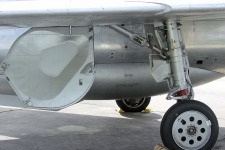 |
The all-aluminium interiors of early post-war aircraft are best exemplified by this Lightning F.1, showing landing gear and covers. (Photo credit: Mark Hayward via Prime Portal) |
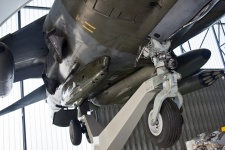 |
The use of Light Admiralty Grey is subtle but distinguishable when contrasted with the whites of the wheel caps and other light greys, as seen on this Harrier GR.3 (Photo credit: 447.insidetrackmagazine.com) |
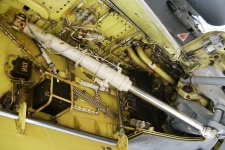 |
The Jaguar's use of zinc chromate primer as an interior color is unique among modern RAF aircraft. The Light Admiralty Grey landing gear can be seen at the bottom right edge. (Photo credit: Howard Mason via Prime Portal) |
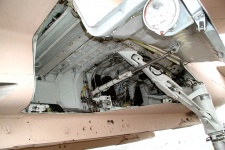 |
This Tornado shows the light gray interior color (possibly Lichtgrau 7035) which is also visible on the Typhoon. (Photo credit: Bill Spidle via Prime Portal) |
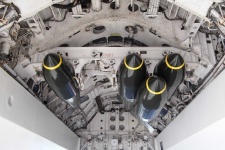 |
The Vulcan's massive white bomb bay was a sight to be hold, and thankfully only ever used to drop conventional bombs. Aside from the Vulcan, V-bomber bays were typically aluminium. |
Color Tables
| FED-STD* | ||||
| BS 110 | Roundel Blue | Roundels, Fins | FS 35056 | |
| BS 241 | Dark Green | Camo (Tactical post-1988) | FS 34083 | |
| BS 284 | Spruce Green | Camo (Harrier II) | - | |
| BS 285 | NATO Green | Camo (Harrier II, Hercules) | FS 34096 | |
| BS 356 | Golden Yellow | Trainers | FS 33538 | |
| BS 361 | Light Stone | Camo (Transports) | FS 33448 | |
| BS 380 | Camouflage Sand | Camo (Desert Pink) | FS 30279 | |
| BS 383 | Camouflage Beige | Camo (Hemp) | FS 30277 | |
| BS 450 | Dark Earth | Camo (Transports) | FS 30118 | |
| BS 538 | Cherry Red | Roundels, Fins | FS 31136 | |
| BS 626 | Camouflage Grey | Camo (Air Defence, Transports) | FS 36314 | |
| BS 627 | Light Aircraft Grey | Camo (Undersides) | FS 36440 | |
| BS 629 | Dark Camouflage Grey | Camo (Tactical) | FS 36231 | |
| BS 632 | Dark Admiralty Grey | Cockpits | FS 36152 | |
| BS 636 | PRU Blue | Camo (PR, Undersides) | FS 35164 | |
| BS 637 | Medium Sea Grey | Camo (PR, Bombers) | FS 36270 | |
| BS 638 | Dark Sea Grey | Camo (Tactical) | FS 36173 | |
| BS 639 | Light Slate Grey | Camo (Short-range) | FS 34159 | |
| BS 641 | Dark Green | Camo (Tactical pre-1988) | FS 34083 | |
| BS 642 | Night | Radomes, Fins | FS 37038 | |
| BS 697 | Light Admiralty Grey | Interiors | FS 36480 | |
* Federal Standard numbers are approximate. All BS 381C colors since 1996 have been specified as semi-matt although equivalent versions of FS paints (FS 2xxxx) may not exist.
